

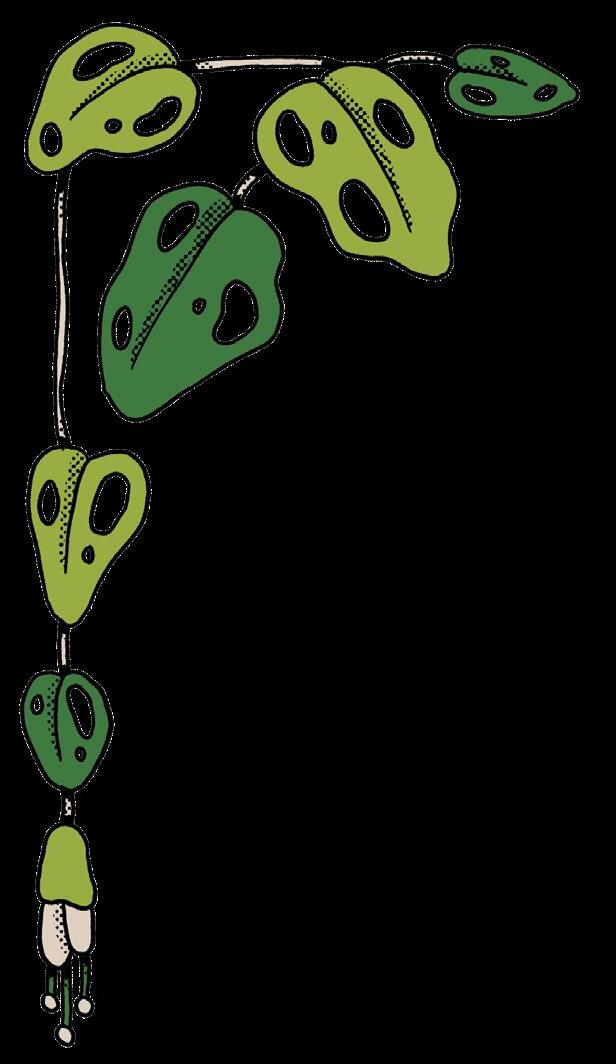
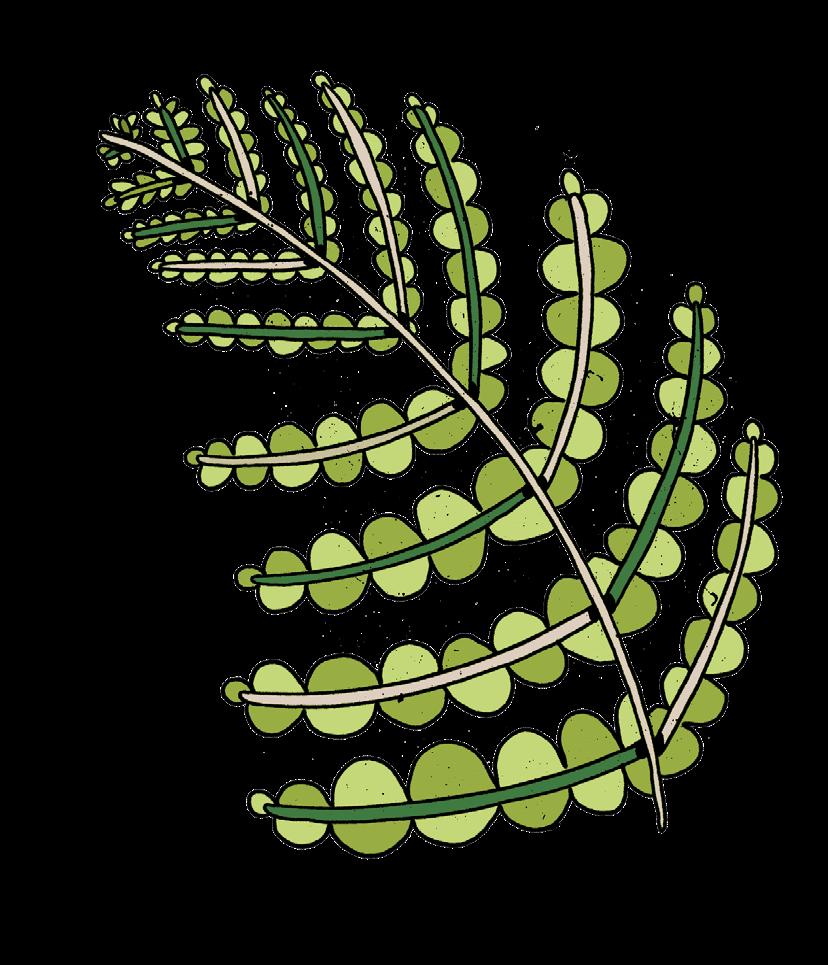


Monday 31st ✦ July 2023
4 Salient is published by, but remains editorially independent from, the Victoria University of Wellington Students’ Association (VUWSA). Salient is funded in part by VUWSA through the Student Services Levy. Salient is a member of the Aotearoa Student Press Association (ASPA).
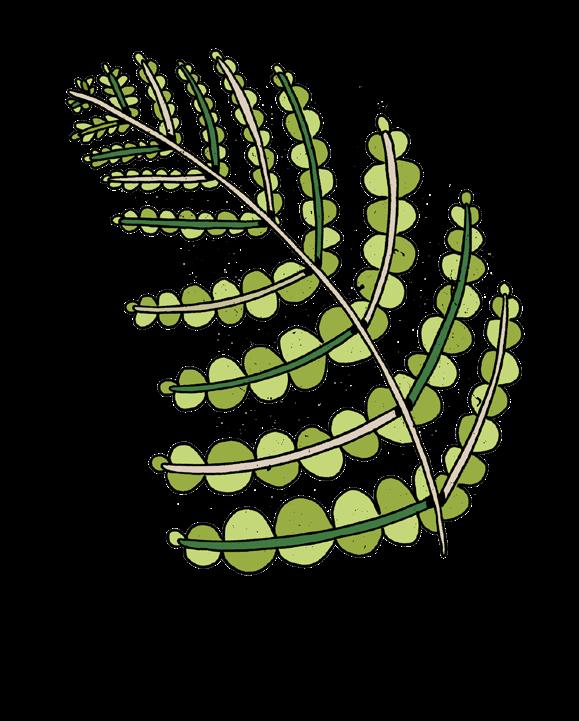
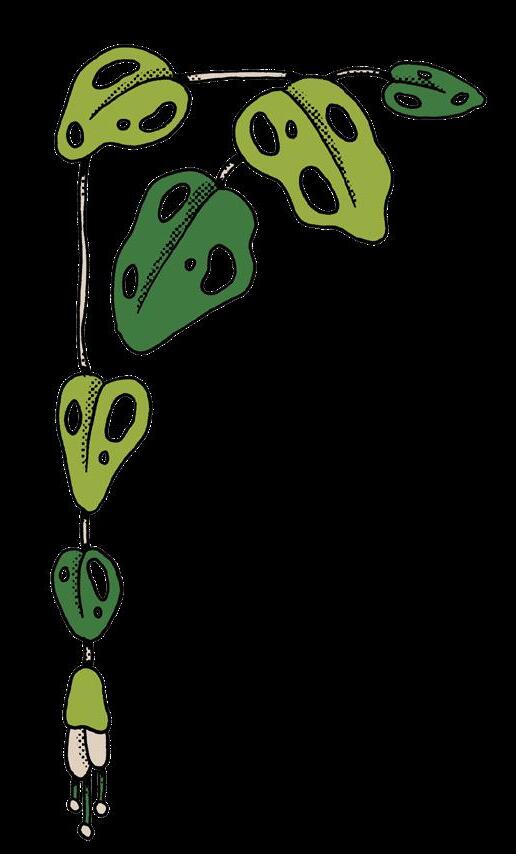
The views expressed in Salient do not necessarily reflect those of the Editors, VUWSA, or the University. Complaints
Complaints regarding the material published in Salient should first be brought to the Editors in writing (editor@salient.org.nz).
If not satisfied with the response, complaints should be directed to the Media Council (info@mediacouncil.org.nz). Letters Got opinions about what we publish? Send it to letters@salient.org.nz and we'll publish it.

11. Introducing Shoot Golden NZ—Francesca Pietkiewicz 12. Books for When the House is Burning—Bridey Newell
The News
Kawe Pūrongo CONTENTS 05. Broke Students Take Advantage of Campus Vending Machine Glitch 06. New Zealand Remains One of Two Countries to Allow Big Pharma Advertisement 06. Massey University Calls for Mass Job Cuts (Join the Club, We’ve Got T-Shirts) 07. Hot Takes in the Hub 08. Candidate Kōrero: Tamatha Paul 10. Headline Junkie
✦ Ahurea
Editorial ✦ Etita
✦
Arts & Culture
Us
About
Salient Podcasts
Waikamihi
17. Te Whanganui-a-Tara—A
22. Te Mana o Ngā Maunga, Te Mana o Ngā Kāhui—Tessa Keenan 26. Microforested—Maia Ingoe Features ✦ Ahuatanga
Podcasts Kōnae Ipurangi
31. Ngāi Tauira 32. Aunty Vic 33. Teaspoonie Columns ✦ Tīwae 7 Puzzles ✦ Panga
Horoscopes ✦ 9 Creative Space ✦ Auhua 3 00 ✦ C0NTENTS ✦ RĀRANGI KŌRERO
Twitter: @salientmagazine Facebook: fb.com/salientmagazine Instagram: @salientgram www.salient.org.nz Find Us
Instagram: @salient_podcasts 14. Climate Justice = Decolonisation— Te
Lambert
Photoseries—Pippi Jean
5
6
8
Catch us on:

The Unedited Session Salient Podcasts
EDITORIAL
E noho ana tātou ki
Te Whanganui-a-Tara


Te Taiao is the environment all around us. It’s the paths that we walk through everyday, the plant matter we interact with, and the entire ecosystem that we are an irrevocably impactful part of.
Te Taiao isn’t confined to national parks and manicured city greenspaces: it’s our backyards, it’s the gutters next to highways, it's the mushrooms growing in our flat bathrooms, in our urban streets and lichen sprinkled fences, curving coastlines, and rural farmland. It’s the whale that visited the Wellington waterfront last week and the critter-filled rock pools off Lyall Bay. It’s the houseplants giving us extra oxygen in the Salient office. This issue aims to question the perspective that the environment is something divided from ourselves. Instead, we want to explore the idea that the environment is a whole system that we are both part of and reliant upon.
While climate change tends to be the best trigger of existential dread, there’s no denying we are in a wider ecological crisis. Globally, humans and livestock far outweigh wild animals: livestock comprises 60% of animal biomass, humans 36%, and wild animals just 4%. In Aotearoa, our biodiversity crisis is well documented, with 94% of reptile species, 82% of our bird species, and 76% of our freshwater species either facing extinction or at risk of it. Most of our freshwater rivers and lakes are choking with pollution and invasive pest species, and our oceans face plastic pollution, overfishing, and acidification, all while having extremely limited protections. The list could go on—but I think that’s enough humans-are-killing-the-planet depression for today.
While we could probably publish a full 24 issues about the facts and figures of our ecological crisis (but we’re already ‘too niche’ so we’ll scrap the idea for now), the stories we want to tell are those that aim to reconceive how we relate to the environment, challenging us to imagine a less destructive future. We want to take the time to think about, and tell the stories of, the environments around us: the ones that are special to us, the ones we live in everyday. We are not as separate from nature as we often think.
We can’t talk about the environment in Aotearoa without talking about mātauranga Māori, decolonisation, and the importance of land back. Colonisation is to blame for the ecological and climate crises we’re facing today. With Māori generational knowledge of places and environments extending far further back than Pākehā have been in Aotearoa, it’s time to step back and listen to those who can tell their stories far better than us. If we want to save ourselves from climate destruction, we need
to let indigenous peoples guide us on how to make change. In this issue, Te Waikamihi kicks us off with an essay on why climate justice = decolonisation, and why kaitiakitanga is crucial to achieving change. Pippi takes us on an urban exploration tour of Te Whanganui-a-Tara through the lens of local photographers. Our wonderful Sub-Editor, Tessa, has her 2023 feature debut, writing about her whakapapa to Taranaki Maunga as he nears official legal personhood, and what legal personhood means for the maunga, awa, and whenua legally recognised this way. Maia takes us on a walk through Wellington’s winding paths and shortcuts, exploring our micro forests just seconds from your front door. We also have a book review, where Bridey tells us what to read when our world is figuratively (or literally) on fire.
In our news section, Zoë and Ethan launch our 2023 Candidate Kōrero election coverage with Green Party Wellington Central candidate Tamatha Paul. Niamh dives headfirst into Big Pharma, investigating why only two countries in the world allow pharmaceuticals to advertise: America and Aotearoa. Niamh and Zoë visit our stinky little friend down the road, Massey University, and investigate why they’re getting robbed of even more staff and course cuts than we are here at Te Herenga Waka. Ethan also tells us about the sneaky, anti-capitalist vending machine on campus that’s giving everyone free little treats.
Also, don’t worry, we saved the daffodils we found for our editorial photo. They’re sitting in a glass milk bottle vase on our desk.
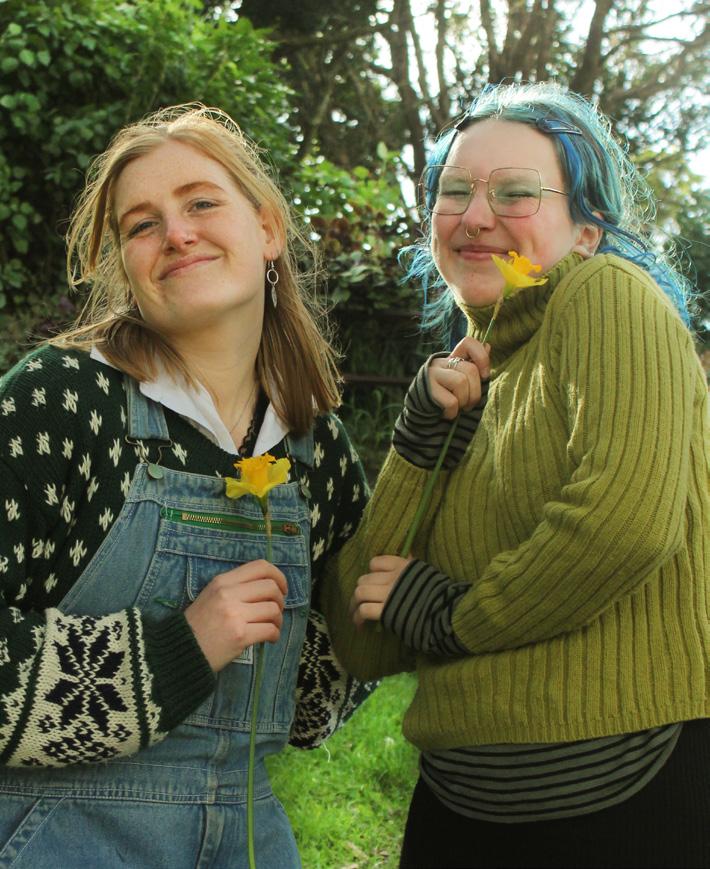
3 Te Taiao ✦
01 ✦ EDITORIAL ✦ ETITA
Arohanui, Maia and Fran xoxo
Salient is fuelled by:
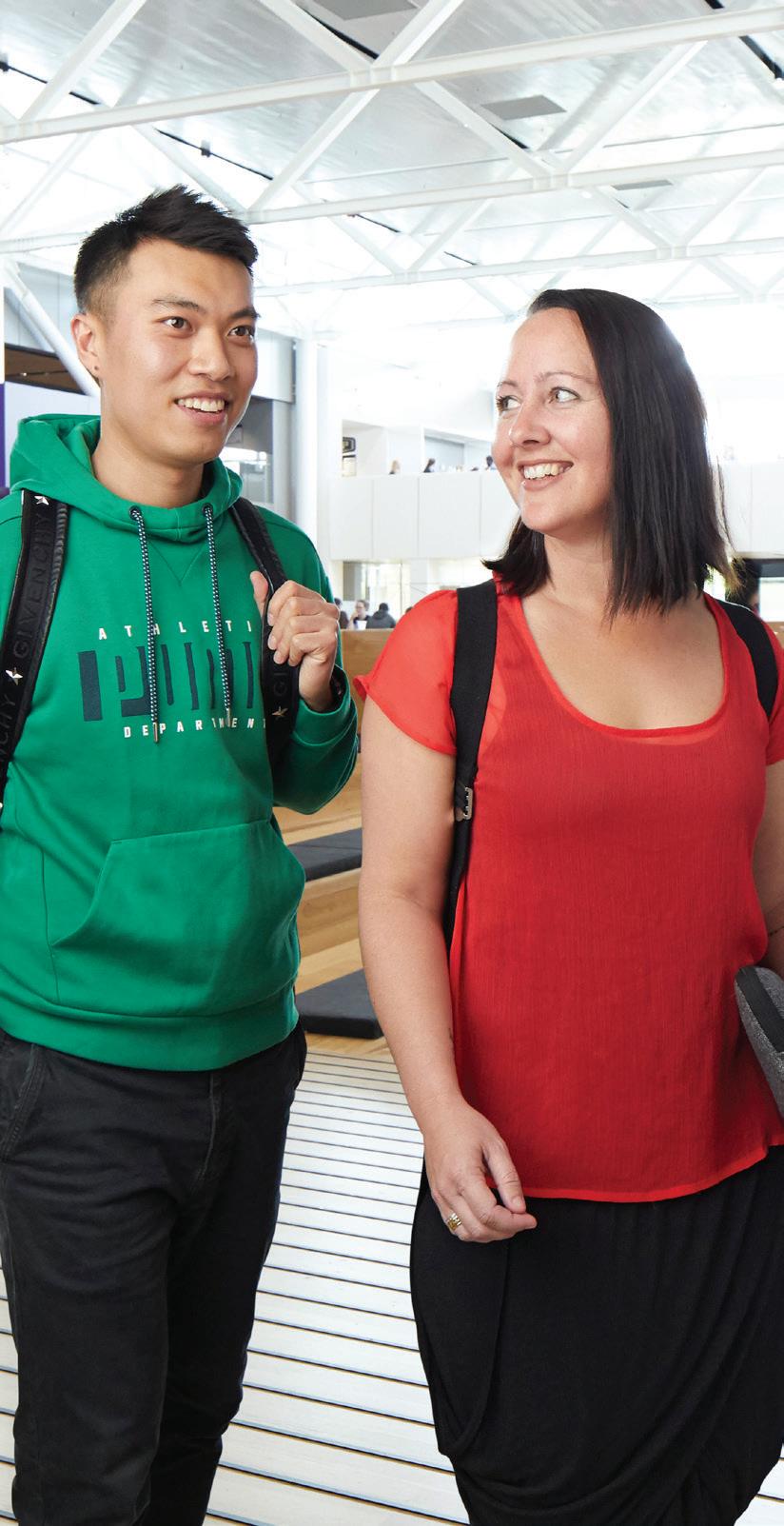

02 ✦ LETTERS ✦ Pū
Broke Students Take Advantage of Campus Vending Machine Glitch
Words by Ethan Manera (he/him)
Students are catching on to an apparent vending machine loophole, getting free sweet treats from a machine that dispenses beverages—specifically, Vanilla Coke Zero Sugar—seemingly free of charge.
Multiple informants told Salient that when paying with Apple Pay, a machine in the Rankine Brown Library displays a message stating ‘Your account will be billed’, but the billing in question never eventuates.
Upon further investigation, numerous university machines have been subject to inconsistent payment, with many students reporting free Vanilla Coke Zero Sugars being dispensed.
Salient took to social media to find out how common these vending machine malfunctions really are. Most respondents said that they too have experienced inconsistent vending. Although most had not discovered the joy of the faulty library machine, ten students said they had received two items for the price of one, and nine students claimed to have been “scammed”, with the vendy taking their hard earned money without dispensing any kai at all.
Mallard*, a third-year student, loves consuming a Vanilla Coke Zero Sugar and has been savouring that sweet cola flavour after returning from an overseas exchange where the beverage is unavailable.

Mallard scored two free Vanilla Coke Zero Sugars from the faulty machine last week. “I didn't notice that I wasn't charged until I looked at my bank account and there was nothing. I looked at my Apple Pay… nothing. It just didn't come up,” she said.

When asked if she felt guilty or feared criminal repercussions, Mallard said, “It's on them, it's a corporation” and urged other students to take advantage of the glitch. “If they cant get their system organised, then just abuse it.”
Although saving a few bucks was nice, it won't make a huge difference financially to Mallard’s living situation. “It definitely tastes nice because it was free, but I would've gotten it anyway.” She said the extra $2 would help her buy “a shaver or something”.
Another student, Jaquelin*, purchased a Vanilla Coke Zero Sugar from a Pipitea vending machine as she “needed a little pick-me-up, ya know?” and was not charged. She claims, “I didn't think anything of it [...] but I checked my bank account multiple times since and no money came out.”
Jaquelin said the free Vanilla Coke Zero Sugar lifted her financial spirits amid the devastating cost of living crisis: “I was so happy about it because basically I’m poor.”
*names have been changed
5 Te Taiao ✦ News the 31 July 2023 Issue Sixteen 02 ✦ NEWS ✦ KAWE PŪRONGO KAWE PURONGO
Massey University Calls for Mass Job Cuts (Join the Club, We’ve got T-Shirts)
Words by Niamh Vaughan (she/her) and Zoë Mills (they/she)
Massey’s Tertiary Education Union (TEU) organiser Ben Schmidt said in a statement that the cuts were targeting the schools of Humanities, Creative Communication, and Speech Language Therapy in particular.

Massey University has joined the slew of tertiary institutions facing major redundancies after further cuts were announced across the university’s three campuses.
The initial number of 125 job cuts jumped to 245 on 18 July, when the Vice Chancellor Jan Thomas issued a statement calling for “voluntary enhanced cessation”, or voluntary redundancy, from members of staff.
These redundancies are an attempt to mitigate debt and financial strain (a story we know far too well here at VUW), with Stuff reporting that the university is currently facing a year-to-date operating deficit of $14.2 million.
Alongside job cuts, Massey is considering axing its Speech Language Therapy degree, one of just two offered in Aotearoa. Speech Language Therapists are already in high demand, as there’s a 20-month waiting list for those in need of treatment.
“It’s outrageous that cuts of this scale are taking place, but what makes matters even worse is the way they are being pushed through via policy changes and voluntary redundancy with no real engagement with the staff who will be expected to pick up the pieces after the dust settles,” Schmidt says. “We call on the Vice Chancellor to stop the cuts and start talking with union members about better ways forward.”
The staff cuts are going forward despite Massey’s academic board being “unequivocally against” the proposal when it was first announced in April of this year.
A number of TEU members and students protested in Palmerston North, outside a Massey campus meeting, in an attempt to uphold the integrity of the school. “A lot of people feel like we're not being listened to,” Georgia Davey, a Massey union rep for the School of Natural Sciences, told RNZ. “We're being ignored because they've already made their decisions.”
The redundancies are still going full steam ahead despite the government announcing emergency funding for tertiary education, with Massey receiving another $12.8 million over the next two years.
New Zealand Remains One of Two Countries to Allow Big Pharma Advertisement
Words by Niamh Vaughan
(she/her)
New Zealand is one of two countries in the entire world that allows big pharma to advertise prescription products to the public. The other country is the US.
On 19 July, the Green Party attempted to table an amendment to the recent Therapeutic Products Bill brought before Parliament, aiming to ban direct-to-consumer advertising for prescription medicines and “protect communities against [their] exploitative advertising strategies”.
The Greens urged other political parties to support the amendment, and was successful in getting a vote towards it from the National Party. “It’s not often that we actually agree with the National Party,” said Green Party health spokesperson, Ricardo Menéndez March, “but it was good to see them actually getting behind the best practice and the evidence.”
The attempted change proved unsuccessful, with the bill passing without the amendment due to lacking a vote from the Labour Party.
Menéndez March told Salient that allowing pharmaceutical companies to advertise comes at the expense of public health. “It creates a power imbalance. [Pharmaceutical companies are] not necessarily focused on public health when [advertising]. It enables those pharmaceutical companies with the most resources to then push their product more aggressively.”
Minister of Health Ayesha Verrall did not support the amendment, despite an open letter calling for the ban boasting the signatures of experts such as former Prime Minister Helen Clark, former Director-General of Health Sir Ashley Bloomfield, Consumer NZ, and all 17 New Zealand medical colleges.
“[New Zealand] may have been leaders on several issues historically,” said Menéndez March, “but on others, we've trailed behind. And [advertising of prescription medicines] just happens to be one of those issues that has been left untouched.”



6 ✦ Te Taiao 02 ✦ NEWS ✦ KAWE PŪRONGO
HOT TAKES
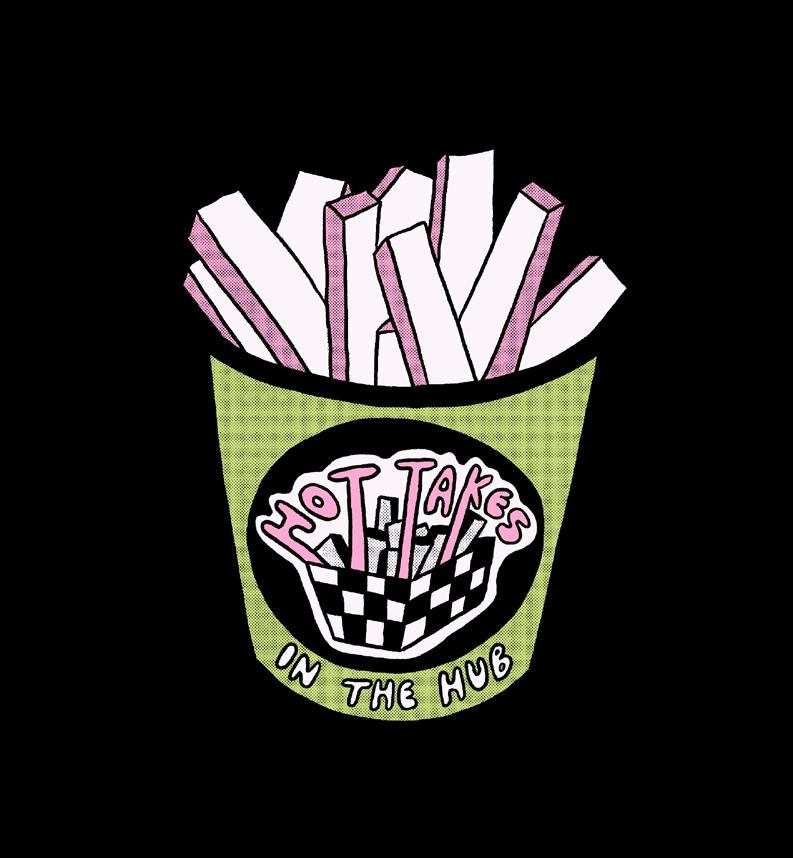

How can Te Whanganui-a-Tara better use its green spaces?


Probably some more seating within the green spaces, because sometimes you just wanna sit and be in the nature and I always struggle finding a seat.
I think some areas make better use of the space than others. I think it should be more equal and some places should have more greenery and nice spaces for people to enjoy.
It was initially designed quite poorly because they didn’t know that there were hills; they just thought it was a flat space… I think getting more cycling pathways is harder than for other cities but that could be better.

02 ✦ NEWS ✦ KAWE PŪRONGO
Emma (she/her)
Cassia (she/her)
I definitely think incorporating free transport for all Wellington citizens would be a better way to get out and enjoy the greenery.
Emily (she/her)
Olivia (she/her)
ELECTION CANDIDATE KŌRERO
Tamatha Paul for Wellington Central
Words by Ethan Manera (he/him)
Despite Grant Robertson having held the seat for 15 years, Paul rejects the idea that Wellington Central is a safe Labour electorate. “It really pisses me off. [...] The Labour Party are not entitled to Wellington Central, and they are gonna have to work a lot harder.”
Running a two-ticks “serious Green campaign”, Paul is confident that she will be able to turn the seat green, saying “Wellington Central is super progressive”. In 2020, the electorate gained the highest proportion of Green Party votes in the whole country.
Housing
When asked what her main policy goal is, Paul said that “the biggest thing that I want to be judged on as in my first term as MP is how many houses I can get built.”
Tamatha Paul (Waikato Tainui, Ngāti Awa) was in Bunnings trying to find a new light for her flat when her phone “started blowing up” with the news that Labour Party MP Grant Robertson wasn’t standing for Wellington Central this year.
After receiving a phone call from Chlöe Swarbrick urging her to “just do it bro” and being pestered around Wellington by Green Party Councillor Thomas Nash, Paul said “the stars just aligned” and she decided it was the right time to run for Parliament.
Re-elected last year to Wellington City Council, the 26-year-old Green Party candidate says her time as a student, 2019 VUWSA President, and past four years on Council has allowed her to be “a real vocal champion for the things that our city needs”.

“I want more public housing and more affordable housing, because I think that if you look at the city, and what is holding us back, it's the lack of affordable housing and good quality housing.”
As an Aro Valley renter, “most of my money that's coming in every week is going on my rent, and that seems to be the universal experience,” Paul said. “We're all paying exorbitant amounts on rent, [...] but we're paying to live in shitholes. We are living in the darkest, dingiest, mouldiest flats. There are landlords in Wellington who get away with this behaviour. We've become accustomed to this idea that it's some kind of rite of passage for young people and for students to live in terrible housing.”
Paul said the Green Party’s rent controls policy, which would restrict landlords to a maximum of a 3% rent increase per year, “will be awesome” for fixing the rental crisis, “because we know our landlords love to just put our rents up arbitrarily.”

8 ✦ Te Taiao
VOTE! ELECTION ✦ CANDIDATE KŌRERO
23
Transport
Regarding Wellington’s bus system woes, Paul said the bus driver shortage is the key issue. “We are really struggling to attract bus drivers to Wellington because why would you drive a bus for $26 an hour when you have to deal with driving on the worst streets in New Zealand, [...] and then go home to your mouldy flat that you live in. It's the city itself that can't attract bus drivers, because who would want to do that?”
In answer to this problem, “First of all, get an MP that actually catches the bus,” she said. “We need to bring public transport back into public ownership because it's these foreign companies who do things like reject the living wage for their workers. [...] We need to reconfigure our streets, take out a whole lot of car parking because it is so hard to drive a bus in Wellington, and we need to make sure that bus drivers have top class facilities at any part of their journey, [such as] access to a toilet.”
Students
On student issues, Paul says she’ll advocate for the policies put forward in the Greens’ 2023 manifesto. This includes making student allowances universal to all students, including postgrads, increasing allowance levels, free public transport for students, extending the winter energy payment to students, and “working towards establishing a 'fee-free' public tertiary education system”.
Paul said although she did “go hard” to advocate for more university funding amid VUW’s recent staff cuts fiasco, she would've gone “even harder” given the platform of a local MP.
“I took real exception to this whole issue, because you've got people making funding decisions in the Beehive who benefited from free tertiary education, and here we are racking up massive student loans having to put big life decisions on hold because we still paying off our loan and having to pay back living costs.”
“So what the heck, what kind of dystopia are we living in that we have to pay back debt for wanting to do something useful and productive for society?” she said.
When asked for her pitch to students, Paul said, “You can send a strong message to the government that you want them to take the cost of living crisis seriously, that you want them to apprehend the terrible landlords that we have to deal with, and improve the quality of houses that we have to live in.”
“If you want them to take seriously protecting nature, and taxing the mega wealthy, and evening the playing field and putting that money to work to bring in a universal student allowance, [...] then the biggest way that you can do that is to vote for me on October the 14th and flip what they think is a safe Labour seat into a Green seat.”
Opponents
Paul isn't afraid to dish the dirt on her fellow Wellington Central contenders, taking aim at the fact that both National’s Scott Sheeran and Labour’s Ibrahim Omer have been living outside of Wellington until recently. “They can’t ride in on the coat-tails of other people and parachute in from Auckland and from Abu Dhabi and do a good job. [...] Who do you guys think you are that you can just come in here and give us what we need? You don't know what we need.”
If successful in getting into Parliament, Paul would vacate her seat representing the Pukehīnau / Lambton Ward on council, causing a $70,000 by-election. “It’s a small price to pay for the democracy and the representation that you deserve,” she said.
Paul said that, ultimately, it's up to the people of Wellington to decide whether or not to send her to Parliament. As she's not going on the Green Party list, she will only leave her position on council if she wins Wellington Central in October.
Listen to the full interview on Salient’s Unedited Session podcast! Stay tuned for more exclusive interviews and election coverage.


9 Te Taiao ✦ 02 ✦ NEWS ✦ KAWE PŪRONGO
VOTE!
Listen to the full interview on Salient's Unedited Sessions podcast! Te Taiao
HEADLINE
USA STEALS REAL FRUIT ICE CREAM

The land of the free have stolen something (and no, I’m not talking about land this time). The New York Times published an article last week describing how the classic Kiwi summer treat of real fruit ice cream has undergone a “sugary American makeover”, which includes adding additional sugar to the dessert and toppings such as oreos, gummies, and sprinkles. According to the article, the increase in demand for real fruit ice cream in the states has been driven by the increase in US tourists to NZ. Angie Morrison, owner of a successful real fruit ice cream shop in the Tasman region told the NZ Herald that the American take on the iconic dessert is “definitely butchering the product. Americanising it and making it unhealthy. There are already outlets who do ice creams where you can put all sorts on it.” President Biden has been contacted for further comment.
BREAK UP WITH TWITTER— SHE’S NOW YOUR ‘X’
Twitter’s new daddy Elon Musk has rebranded the social media platform we once knew as Twitter to X. Users of the app discovered that the familiar bird logo had been swapped for a minimalistic, black X last week, to signify the app’s new ownership under Musk’s X-Corp. "The Twitter name made sense when it was just 140 character messages going back and forth […] but now you can post almost anything, including several hours of video. In the months to come, we will add comprehensive communications and the ability to conduct your entire financial world,” Musk wrote in a tweet (YES I’M STILL CALLING IT THAT). The reception of the change has been mixed, with one user writing, “This whole X thing is identical to the failed attempt to rebrand Vic Uni a few years ago.” Fellow bird, the Duolingo Owl, is yet to issue a statement on the matter.
FOOTBALL FERNS STRIKE OUT AGAINST THE PHILIPPINES
Aotearoa’s football ferns faced a dismal 1-0 loss against the Philippines’ Women’s National Football Team last week, just a couple of days after the Ferns’ historic win against Norway. Over 30,000 fans packed into the Cake Tin last Tuesday to cheer on the teams. The Philippines’ Sarina Bolden scored the winning goal 23 minutes into the match, securing the team’s first ever win in the FIFA Women’s World Cup. “We played to win today and it didn't go our way,” said the Ferns’ coach Jitka Klimková, “[...] we were fighting to the end but it was not enough. We were missing that little piece in our execution.” The Ferns are set to play a makeor-break match against Switzerland on Sunday (don’t ask us for the score, we go to print on Thursdays).
HIGHEST NUMBER OF UNI DROP OUTS SINCE 2014
The Ministry of Education confirmed last week that students are fucking over it, with university course completion rates dropping from the 2020 high of 89% to 86%, the lowest course completion rate since 2014. According to RNZ, a number of factors have resulted in the decline, such as the post-covid effects of online learning. The cost of living crisis has been cited as a major cause by universities, who say that students are having to put more time into earning an income to support themselves and their families instead of studying.
“Covid has been really difficult for students in general and that has had a really disproportionate impact on different student communities,” VUWSA President Jessica Ye told RNZ “Covid has really tested the way students learn as well and online learning has been really difficult. It's been a relatively unsupported environment for academics to teach to students.” The trend has been felt across the tertiary sector, with the University of Waikato, AUT, VUW, and Otago University all reporting significantly lower pass and course completion rates over the past few years.
10 ✦ Te Taiao 02 ✦ NEWS ✦ KAWE PŪRONGO
INTRODUCING SHOOT GOLDEN NZ

Making Art out of Flowers, Nail Polish, and Coconut Oil
Words
On the last Sunday before we started back at work, Bella and I journeyed our way through Te Aro toward the historical glory that is Inverlochy Art School to attend an art workshop. The Chemigram Workshop was hosted by Shoot Golden NZ and their founder Fatima Grant. Shoot Golden NZ is an actively inclusive and sustainable photography organisation and ecommerce retailer. I talked with Fatima about their kaupapa and vision for photography.
“I started Shoot Golden NZ in December 2023, based in Wellington. As a female, LGBTQIA+, and Filipino-owned photographic business, I feel that as an underrepresented individual, it is my purpose to inform and inspire our creative communities. My own motto, ‘it's now or never’, is how Shoot Golden NZ was born,” Fatima said. “My vision for the business came together due to my background in a multitude of creative practices including photography, fine arts, gold and silversmithing.”
Upon arrival, Fatima sent us foraging into Inverlochy Art School’s surrounding gardens for our artistic practice. I felt transported back to a school holiday programme from my childhood, collecting lavender, leaf skeletons, and pretty petals. It was glorious. We would be making chemigrams, which are produced from an experimental form of darkroom photography that involves painting on and placing objects onto light-sensitive photographic paper.
“Shoot Golden NZ focuses on trading restored, refurbished, and otherwise saved analogue equipment with the aim to keep this gear out of landfill and in the hands of practising creatives,” Fatima told me. “Our kaupapa is strongly connected to reducing our carbon footprint on the planet, [and] encouraging like-minded people to support local businesses and shop sustainably.”
“Analogue photography forces the user to slow down and appreciate the environment around them. Having a limited number of exposures, one has to be selective in how you document your surroundings. This is what drew me to photography in the first place.”
“In the Chemigram Workshop, I ask participants to take ownership of their work by looking to their surrounding environment for inspiration, collecting found objects such as foliage. [They then focus on] repurposing them throughout their work to contrast the abstract textures chemicals create, thus allowing the creative process to be natural and unique to each individual.”
After you’ve made your masterpiece out of household objects and botanicals, you expose it to light under an enlarger. Bella and I both agreed that the process of spraying coconut oil, squirting and spreading toothpaste, and drip dropping nail polish over our flowers reminded us of the types of joyous potion making and finger painting we did as preschoolers. Finally, you discard the beautiful mess off your canvas, take it through the developing process, and hang it up to dry.
It was an honour to attend Shoot Golden NZ’s first workshop. The whole workshop was a gorgeously freeing experience. It took the stress out of creativity that Bella and I often experience as working creatives. We were allowed to be kids again.
“As a predominantly self-taught photographer, I noticed a lack of inclusive and supportive spaces for exploring analogue photographic practices for art students and creatives alike,” Fatima explained.
“We run workshops for this very reason, allowing curious minds to learn these skills, including black and white film developing, cyanotype, chemigram, and photogram classes, to name a few scheduled throughout the year.”
Find Shoot Golden NZ here:
Website: shootgoldenz.co.nz
Instagram: @shootgoldenz
11 Te Taiao ✦
by Francesca Pietkiewicz (she/they)
03 ✦ ARTS & CULTURE ✦ AHUREA
B OOKS FOR WHEN THE HOUSE IS B URNING
Words by Bridey Newell (they/them)
I find what often deters people from climate change literature is a fear that it’ll be pretentious and preachy.
Maybe we feel that books about climate change are not as aware or intimately acquainted with global warming as we are. I mean, we’re 90s-to-early-2000s babies. We’ve spent our lives entering adulthood deep within the Anthropocene. Even outside of climate change, Gen Z is a generation caught up with the importance of individual responsibility. We receive calls to action via our (globally aware) social media every week.
On top of climate change, we’re living in a century that has witnessed the rise of #BLM, Covid-19, #MeToo, and so much more. The role of the individual has been characterised as the core of political change, yet the individual is powerless unless they force
the hand of the powerful. Fun fact for you: BP invented the term ‘carbon footprint’. It makes sense that literature would encourage us and inspire individual action against climate change—and when we’re living in it, we don’t need it to be over-explained to us! We don’t need to be told to care. I get it…
But I see little reason to endorse sitting on our hands. Comfort avoidance dressed in nihilism’s clothing can’t give us much. So, the books I’ve chosen to review here are not meant to ‘open your eyes’ to the catastrophe that’s been unfolding since before we arrived on Earth, for better or worse. They are intended to help you examine the climate crisis and the environment from new angles, challenging your perspective—as all good storytelling is meant to do.
The Overstory by Richard Powers
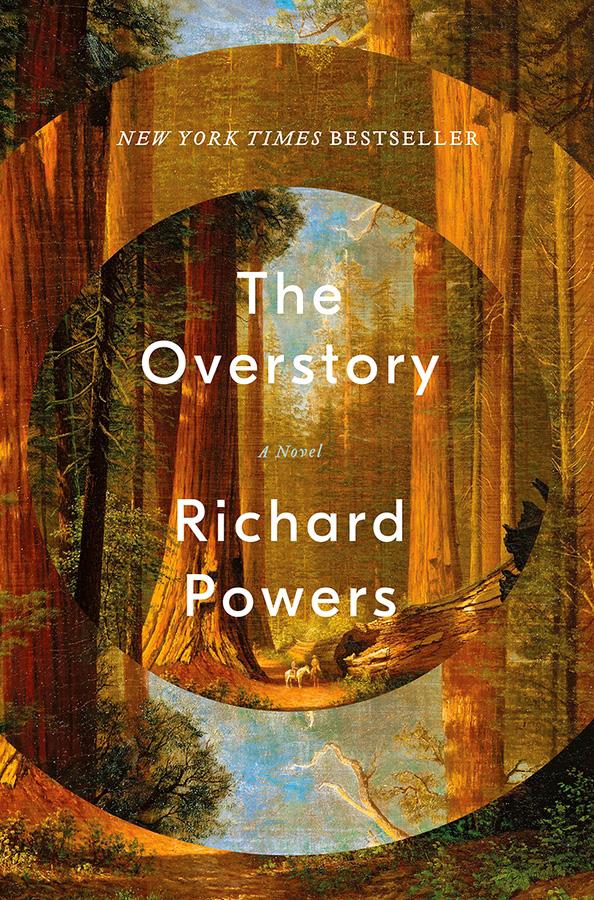
Oh Lordy, you know when you read or watch something and you’re kind of just like, ‘everyone needs to experience this’? The Overstory is one of those things! In all honesty, this is a book I think anyone could enjoy.
The Overstory isn’t about climate change as much as it’s about trees. If you watched FernGully: The Last Rainforest, read the Lorax, or planted trees in your community with your primary school class as a kid, this book has the uncanny ability to bring you back to those moments. Primarily set in the 90s (but also not, but kinda, but not really), The Overstory explores the kinds of thinking that drive industry, conservation, protest, and eco-radical action that we first glimpsed in childhood. It’s philosophical, passionate, and yet unpretentious in the way that many people might find fiction about deforestation to be. Honestly, this book is phenomenal. I’ve recommended this book to everyone: my flatmates, my boyfriend, my coworkers, even to a woman selling plants at a Saturday market in Nelson.
Richard Powers says he read over 120 books on trees as research for writing this book, and it shows. But it doesn’t read like a Wikipedia page by any means. Powers’ writing is strong, well paced, and keenly interested in making sure the reader remembers every word (which is pretty hard for a 625 page book).
The Overstory is available at Good Books for $26.
Bangkok Wakes to Rain by Pitchaya Sudbanthad
At my most concise, I can say Bangkok Wakes to Rain is about the scale at which time allows change to unfold—be that rapid or slow, minute or extreme. Spanning over a century, this novel depicts the eponymous city and its citizens going through the motions of history. Sometimes tragic and threatening (as history often is), Bangkok Wakes to Rain constantly searches for beauty and seeks to build a vision of an optimistic future. Memories, ghosts, and imaginations of utopian futures and pasts that honour the climate all retain an illusive lustre here. Through Sudbanthad’s poetic prose, we’re able to hold these realities in our hands, however momentarily.
If you’re still not convinced but want a book that isn’t strictly about climate change and is more concerned with culture, people, and our place within this world, then you’ll probably enjoy this one.
Bangkok Wakes to Rain is available at Paper Plus for $32.

12 ✦ Te Taiao 03 ✦ ARTS & CULTURE ✦ AHUREA
✦ ✦
✦ ✦
The Earth Transformed: An Untold History by Peter Frankopan
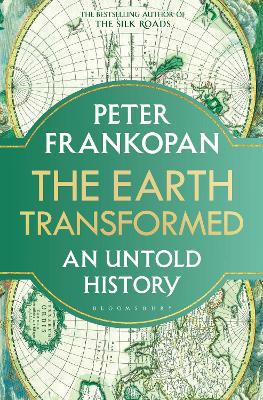 Written by historian Peter Frankopan,
Written by historian Peter Frankopan,
The Earth Transformed is both wildly interesting and satisfying. It’s a novel that explores human curiosity, deep diving into the rich history of our species. Retelling the history of the earth from the very beginning (as in 4.5 billion years ago), we, through Frankopan’s words, witness various climate changes through the ages. Eventually, The Earth Transformed becomes a chronicle of our relationship with the weather, God, and nature. What I appreciated most about this book was its thoroughness.
Frankopan gives time and attention to the ecological and meteorological histories of as many civilisations, communities, and landscapes as possible. The book seems only Eurocentric to the point that it is focussed on the role European imperialism has played in climate change.
The Earth Transformed is available at Unity Books for $45.
Regenesis: Feeding the World Without Devouring the Planet by George Monbiot

I’m fond of all the books discussed so far, but this one was a pleasant surprise for me. Not because I expected to dislike it, but because it’s a bit out of my area of personal and academic interest. Regenesis is a non-fiction exploration of sustainable agriculture in the UK, told by George Monbiot as he travels between farms. He brings us along as he learns about the unconventional techniques farmers are employing to ensure the health of their soil. If you’re studying the sciences or have an interest in agriculture, this book would definitely be up your alley. Studying a Bachelor of Arts, I knew to keep my expectations tethered and approach this one with a modicum of humility. I know very little about soil microbes. But Regenesis was charming—Monbiot seems to understand that interest, not prior knowledge, is what drives learning. And as a result, his writing is both accessible and attentive to the priorities of the layman and the farmer.
Regenesis is available at Paper Plus for $37.
Braiding Sweetgrass by Robin Wall Kimmerer
Braiding Sweetgrass weaves together indigenous knowledge and biological science to build stories of our natural world and how we can reconnect to it. Robin Wall Kimmerer is an indigenous American of the Potawatomi nation, and a decorated professor and scientist in environmental science and biology. Braiding Sweetgrass is poetic and heartfelt, and tells stories from a place of home and family. Each chapter imparts a lesson on how to care for the world outside of yourself. It is a must-read for anyone who cares for the environment today.
Braiding Sweetgrass is available from Unity Books for $26.

13 Te Taiao ✦ 03 ✦ ARTS & CULTURE ✦ AHUREA
✦ ✦ ✦ ✦
Climate Justice DECOLONISATION
Ko Pūtauaki te maunga
Ko Rangitāiki te awa
Ko Mataatua te waka
Ko Uiraroa te marae
Ko Ngāti Awa te iwi
Ko Ngai Tamawera te hapū
Ko Te Waikamihi Lambert ahau
Dear reader,
As you read through my pepehā, I want you to notice the way it flows. Try to picture my mountain, Pūtauaki, standing tall in the distance, below which my people have resided for many generations. In front of it, you can see my ancestral river, Rangitāiki, carving a path through the land and sustaining all life around it. On that river sits the Mataatua canoe which carried many tīpuna of mine from Hawaiki all the way here to Aotearoa. That waka is on its way to my marae, Uiraroa in Te Teko, where my tribe, Ngāti Awa, and sub-tribe, Ngai Tamawera, await me with open arms and a spare tea towel. This is my tūrangawaewae, my place of belonging, to which I am intrinsically connected.
The environment exists in a multitude of forms: mountains, grasslands, wetlands, deserts, rainforests, oceans, glaciers. Indigenous people exist within these systems, observing and interpreting the land and creatures around them. The way in which indigenous people perceive the environment is reflected in cultural values, societal norms, stories, songs, customs, and traditions. This is best demonstrated in pepehā, and the Aotearoa-wide reclamation of its place in our society as an important tradition which is shaped and informed by the environment. Back home, our ancestral mountain Pūtauaki is referred to in songs and stories as ‘Koro’, meaning grandfather. In this display of the Māori worldview, the environment is not only alive, but a part of my family and genealogy.
Western science inherently tries to compartmentalise and classify the environment into divisions, whereas indigenous knowledge asserts that all parts of the environment cannot live in isolation of each other. In Te Ao Māori, all living beings are interconnected by mauri: a life-force binding the physical world to the metaphysical. When the mauri of the environment is diminished by pollution or desecration, the mauri of the people is directly impacted. They may become sick, or feel unbalanced and unsettled. On the other hand, when we sustain and nourish the environment, the environment will sustain and nourish us. Mauri is restored.
14 ✦ Te Taiao
04 ✦ FEATURES ✦ AHUATANGA
Words by Te Waikamihi Lambert (she/her; Ngāti Awa, Ngai Tūhoe, Ngāti Ruapani, Ngāpuhi)
= Justice DECOLONISATION
Kaitiakitanga is a term often translated in Pākehā legislation to mean stewardship or custodianship of the environment. These definitions don’t encompass the many intricacies and complexities of kaitiakitanga. Kaitiakitanga is not one size fits all. It must be defined by localised knowledge of the environment to reflect bespoke issues, values, and aspirations. Stewardship is a choice which can be accepted or denied. Kaitiakitanga is an inherent responsibility Māori have to past and future generations to care for the environment. It is a way of life which brings forward sustainable solutions.
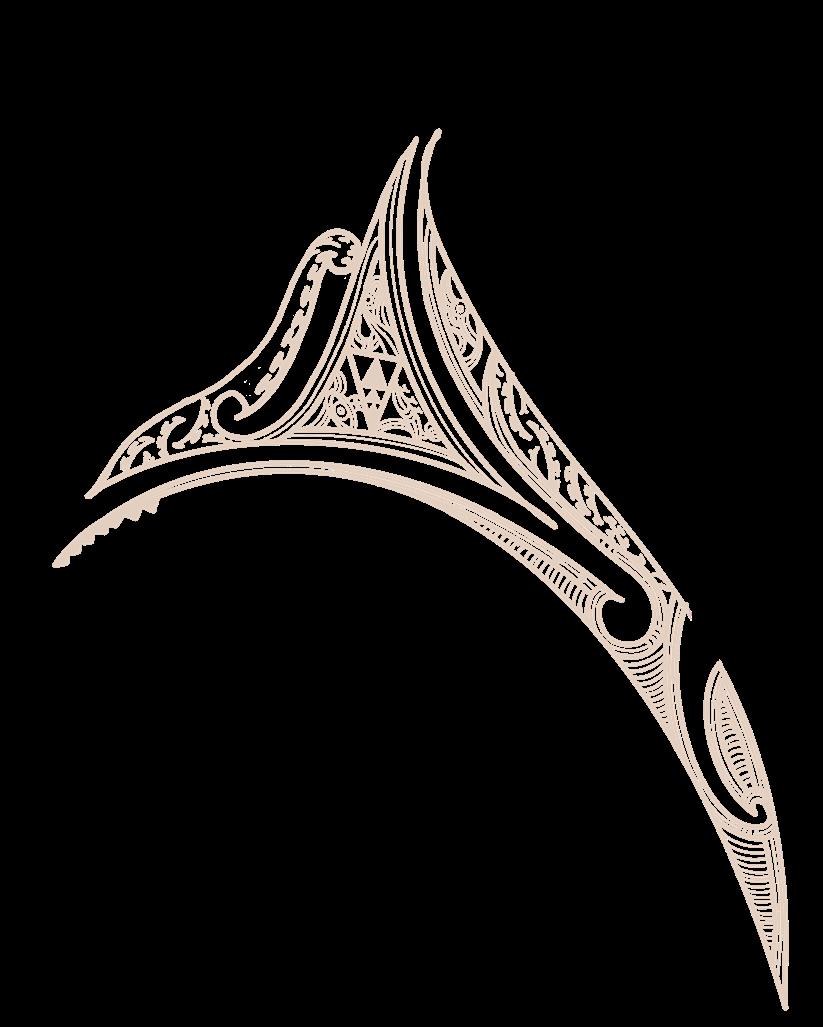
In our current environmental management system, scientists record the environmental state of an area at the start of their career and use this as a baseline for comparison. As the generations age and shift, the accepted norm for the state of the environment gradually changes due to lack of past information and past experience— a phenomenon sometimes known as ‘shifting baseline syndrome’. However, mātauranga Māori and indigenous knowledge has the potential to tap into historical accounts of an area through intergenerational knowledge—that which is transmitted from generation to generation in communities living in one area. This helps to identify wider environmental impacts that may not have been noticed. With all of the environmental crises we are faced with today, it’s more important than ever to have indigenous voices frontering the management of our natural resources.
The United Nations Department of Economic and Social Affairs states: “Climate change poses threats and dangers to the survival of indigenous communities worldwide, even though indigenous peoples contribute the least to greenhouse emissions.” Indigenous people contribute the least, and yet we suffer the most because of our close connection to, and dependence upon, the environment. The climate crisis aggravates the challenges already faced by indigenous communities: economic and political marginalisation, loss of land and resources, and poorer health outcomes. The potential threat climate change poses to the existence of indigenous people, combined with legal and institutional barriers that inhibit our capacity to adapt to climate change, makes it an issue of human rights and inequality.
Climate justice is a human-centric approach to tackling the climate crisis by addressing the many intersecting systems that fuel it, such as capitalism, economic growth, colonisation, racism, exploitation, slavery, and resource extraction. To understand how we ended up in this climate emergency in the first place, we must look at history. It’s no secret the industrial revolution catalysed the speed of rising temperatures. This mass burning of fossil fuels could not be possible without oil and gas from developing countries. Colonisation forged the exploitation of oil and gas resources in these countries, and slave labour financed the industrial revolution.
15 Te Taiao ✦ 04 ✦ FEATURES ✦ AHUATANGA
Colonisation forged exploitation oil and gas resources in these countries, and slave labour financed the industrial revolution.
The history of climate change is riddled with racial and social injustices, and such harm is still being felt today. In Canada and North America, oil and gas productions were unlawfully erected on indigenous territories, and pipelines were built beneath local schools and communities. Indigenous communities living nearby experience more health issues associated with air pollution and water contamination.
Oxfam’s latest research with Stockholm Environment Institute shows that the richest 1% of people emit twice as many emissions as the poorest 50%. In reality, the people who contributed least to the problem are the most vulnerable and unequipped to survive, whilst the biggest polluters live in the best care. The climate movement is not just about protecting the planet, it’s about caring for the people who live on the planet.
Climate change is being fueled by an unsustainable, capitalistic system in which the economy must constantly grow despite being located on a planet with limited resources. Biodiversity suffers at the hands of a few who cannot see when enough is enough. The system is not broken, it’s working exactly as colonisation designed it. Climate justice requires new environmental policies to encompass human rights, indigenous justice, and racial justice on a global scale.
Decolonising for climate justice looks like giving precedence to indigenous knowledge and kaitiakitanga; supporting indigenous nations to work on green technology and renewable energy, and developing more holistic environmental management tools such as legal personhood (See Tessa’s article on page 22!). Ultimately it is caring for the well-being of the environment and the people.
Toitū te marae a Tāne, toitū te marae a Tangaroa, toitū te iwi. If the land is well, and the ocean is well, the people will thrive.

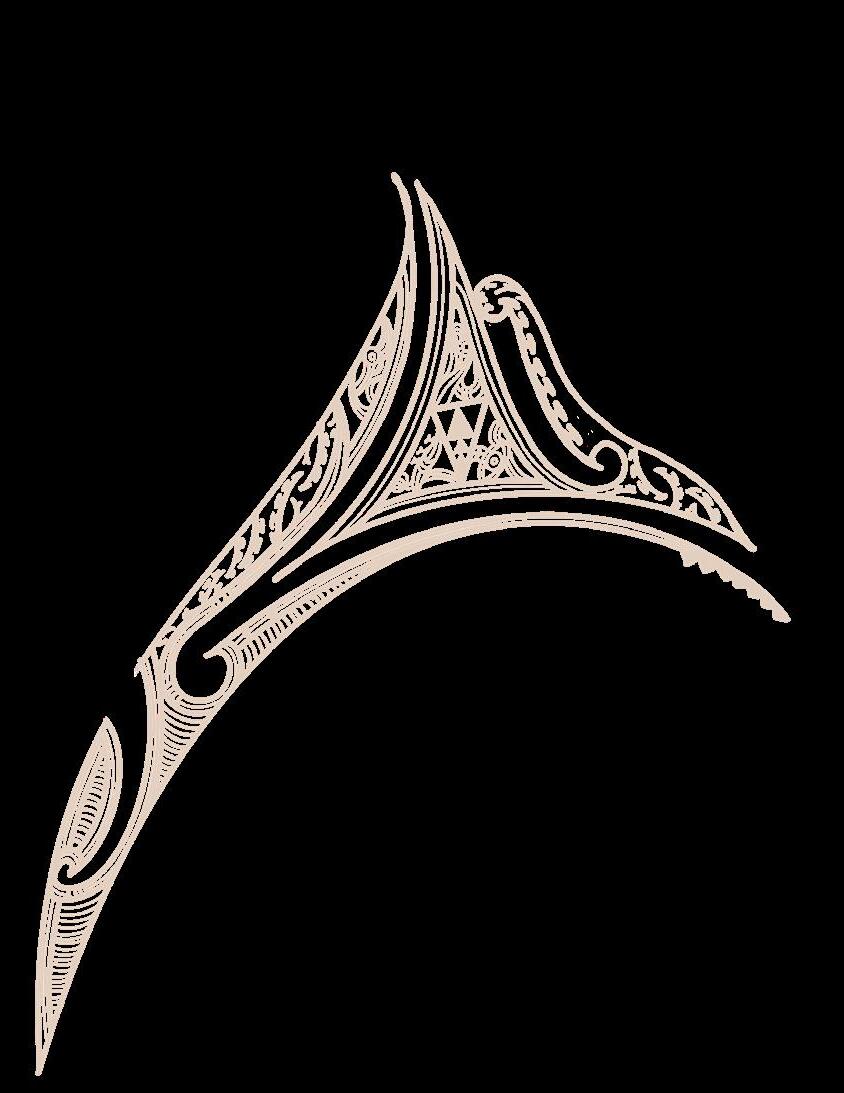
16 ✦ Te Taiao 04 ✦ FEATURES ✦ AHUATANGA
Nāku iti nei, Te Waikamihi
"
"
T E W HANGANUIA-TARA A PHOTO SERIES
 Words by Pippi Jean (she/her)
Words by Pippi Jean (she/her)
“Through my camera lens, I've been able to capture the stunning cityscapes and breathtaking coastlines of Pōneke. Exploring film photography [is] particularly rewarding. It encourages me to slow down, observe the finer details, truly appreciating the art of capturing moments.” - Tom Lee
Film as a photographic medium is grounded to place and time. It captures a moment in freeze frame, only revealed again after it’s developed. There’s a sense of immediacy, specificity, and space, and a deep consideration for your surroundings. So, for ‘Te Taiao’ issue, I asked local film photographers to tell me about their favourite locations in Te Whanganui-a-Tara, and how taking pictures helps them explore and honour their connections to these environments.
"I shot [my] street fashion series in central Wellington, particularly around Cuba Street and its sideroads. The Cuba Street area draws interesting characters and stimulates that unique Wellington essence,” Felix says. In a Capital Magazine interview, he said he found Cuba Street’s “playful vibe” was reflected within the fashion. He shoots 35mm film on a Nikon F50. This camera choice, along with the spontaneity of asking randoms if he can photograph their fits, make Felix’s images look raw, timeless, and joyful. He says his photographic process focuses on the “symbiotic relationship” between people’s steez and the “vibe” of the place where he spots them.
“I draw a lot of inspiration from the people and the spaces they inhabit,” he says. “Street fashion is a perfect representation of Wellington's diversity and authenticity."
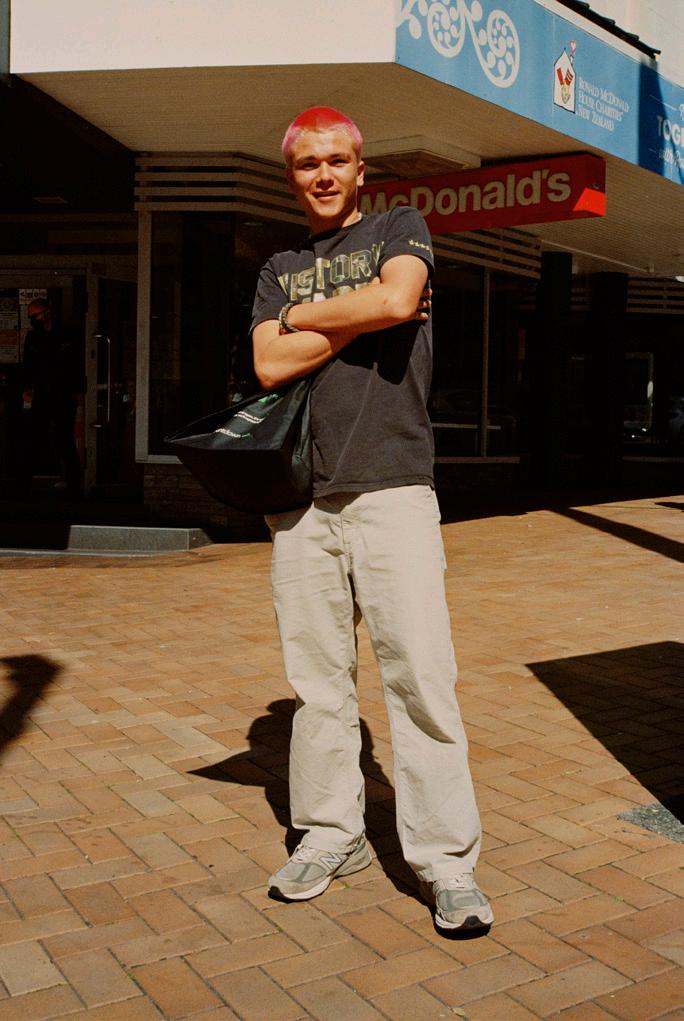
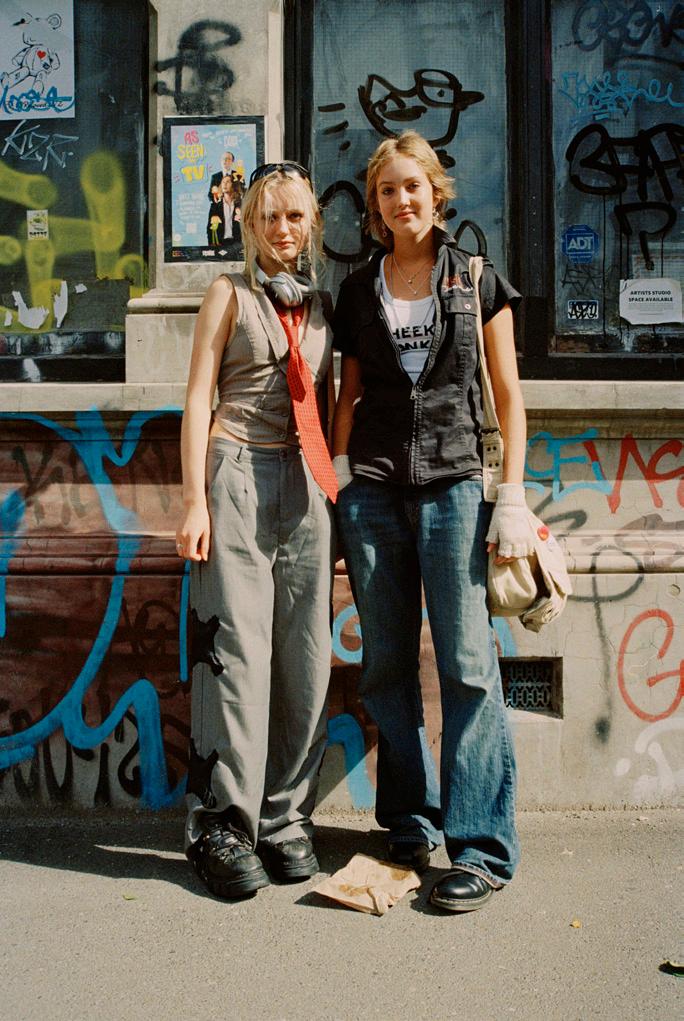
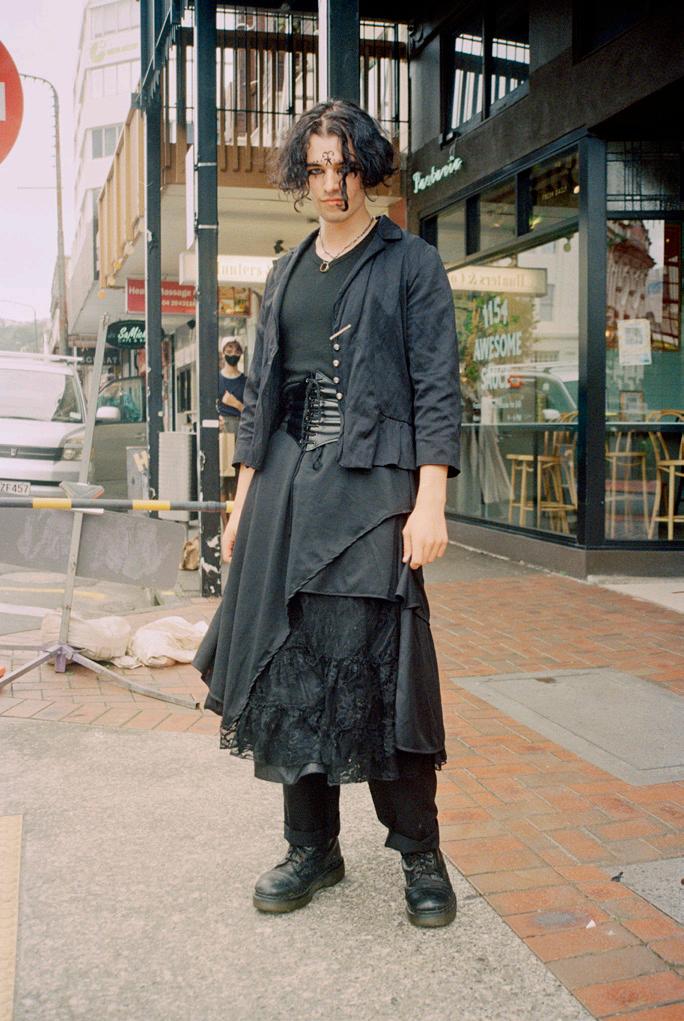
04 ✦ FEATURES ✦ AHUATANGA
FELIX JACKSON (HE/HIM) (NIKON F50)—@FELIXRJACK
ROISIN KENNY (SHE/THEY) (CANON EOS 500N)—@ROISINFILM

01. ORIENTAL BAY HOUSES
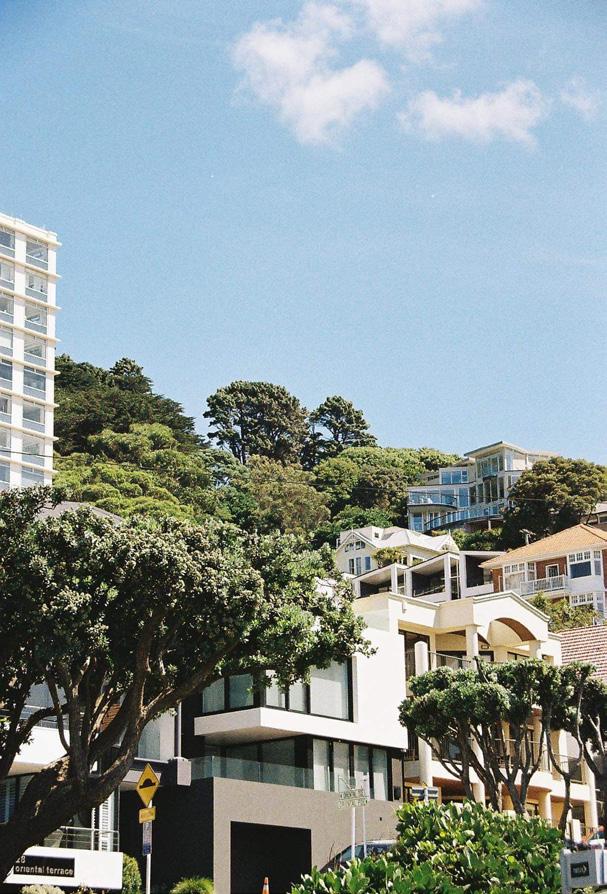
Roisin took this shot on her way home from a surf lifesaving job last summer. She describes how she believes that Oriental Parade is a key part of Wellington's heart and infrastructure. “The architecture of the buildings all baked into the hillside make for a picturesque border for the bay!” This is one of her favourite photos she’s taken.
02. KAPITI ISLAND/PAEKĀKĀRIKI
Having always lived coastally, Roisin is drawn to taking pictures of the Wellington seaside. This shot was supposed to be a “quick snap to finish off the roll”, but it surprisingly developed well. Visiting Paekākāriki always makes her wish she had her camera on her. “[It has] such a gorgeous coastline. […] I always want to memorialise how the ocean makes me feel. FIlm is very nostalgic, I find it gets those kinds of emotions across easier.”
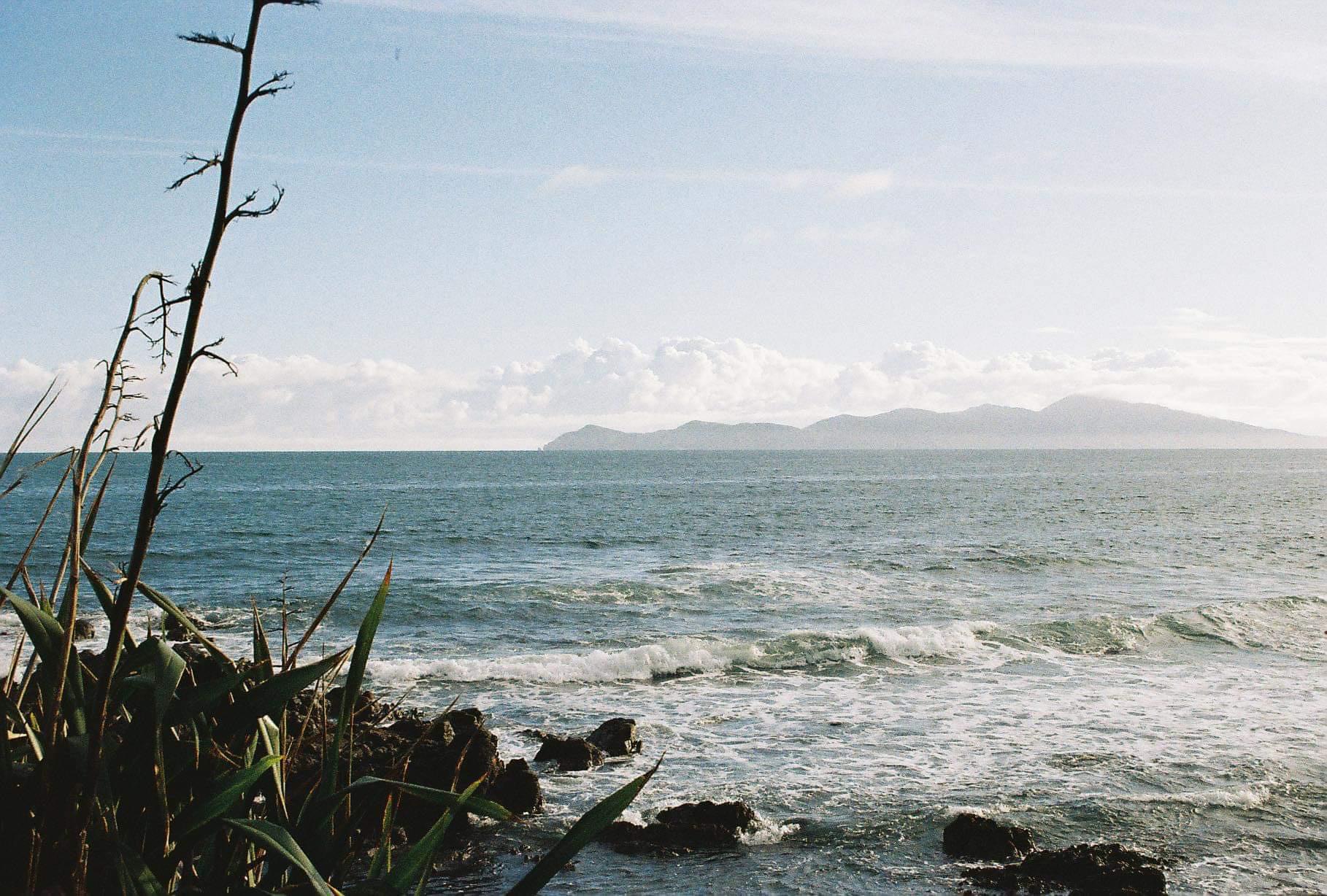
LOGAN CALDER (THEY/THEM) (ASAHI PENTAX SPOTMATIC F)—@LOGANIZCRINGE
01. BLUEWATER BAR AND GRILL
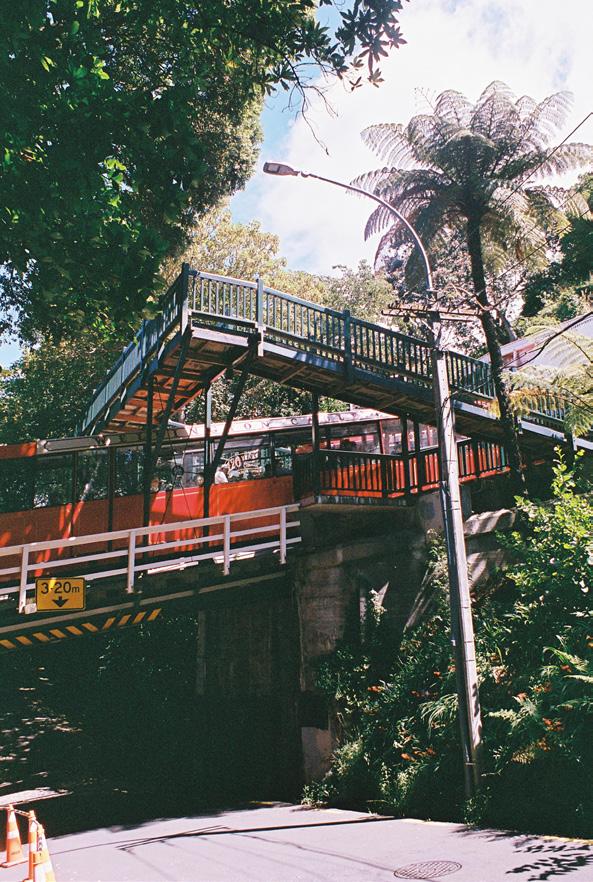

After buying their first film camera—an Ilford FP4 125—and spending almost a week pulling the camera apart to repair it, Logan went down to Splendid Photo to buy their first roll of film. To figure out how to shoot film, Logan took a walk “around Oriental Bay, just shooting scenes that caught [their] eye.” This picture of Bluewater Bar and Grill is one of the first pictures they took, and remains a favourite. Now, this place "represents a sense of accomplishment” for them, as a kick-starter of their love for film photography.
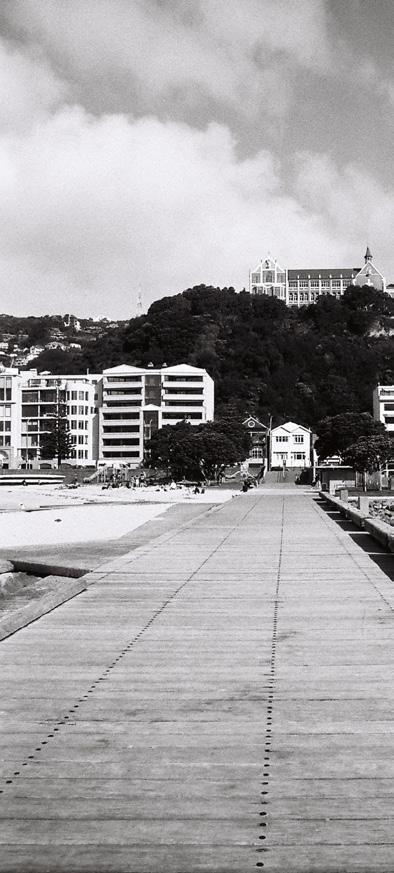
Logan describes to me the creative process behind taking this photo. “I stood in this spot for ten minutes, waiting for the cable car to pass by.” Well-loved tourist attractions can draw flocks of photographers, but Logan was able to get a moment to themselves to watch the sunset from Everton Terrace. That moment resulted in this shot. “I absolutely love the warm tones you get from using Porta 400,” they say. “It’s my favourite film for golden hour shots, and for shots that [I want to] feel close to home.”

04 ✦ FEATURES ✦ AHUATANGA
02. CABLE CAR
01.
Tom took these photos on the green belt at Mount Victoria, using a Pentax ME and Ilford XP-2 film. Wellington’s green spaces are an indelible part of our community, character, and culture, and often the first thing my visiting friends from Auckland point out. “I think Mount Vic is a unique space where you’re encapsulated by nature while still being so close to the heart of the city,” Tom says. He goes on to explain that the maunga feels like a place of shelter, and that he feels privileged to have access to these spaces.


02.
Surfing is a cherished hobby of Tom’s. He recently decided to combine it with his love for photography. This series of photos was taken at the “famous corner” in Lyall Bay, using the waterproof Minolta Weathermatic and Ilford XP-2 film. Taking film photos in the surf, Tom says, presents some difficult challenges. “Contending with the usual issues of composing a good shot,” he says, “you're also embroiled in the crashing waves and the other movements of the ocean.” He says taking the camera out on the water in Wellington has given him a unique perspective on both photography and surfing. The challenge of the Lyall Bay location gives him “immense joy”.
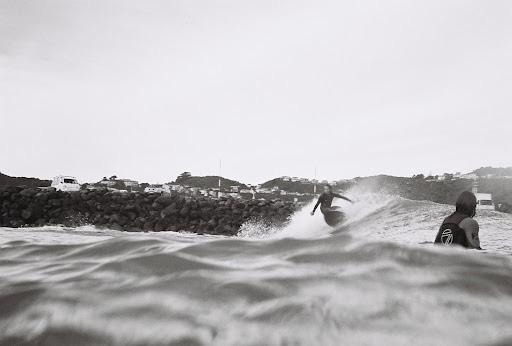
TITAN SCHOFIELD-FREEMANTLE (HE/HIM) (SONY WITH A 18-135MM LENS)—@TITANISEDITING
01. HARBOUR
This photo was taken from the Wahine Memorial by Te Papa. Titan has highlighted the red boat in isolation, and desaturated the rest of the blues and greens in the surrounding waterfront. “Even though I’ve been [in Wellington] for a while, I still find unique things to capture each time” he says. Titan shoots digitally, but often edits his photos to look like film. Experimenting with colour—both while shooting and during post-production editing—are equally part of how he draws artistic attention to the images.
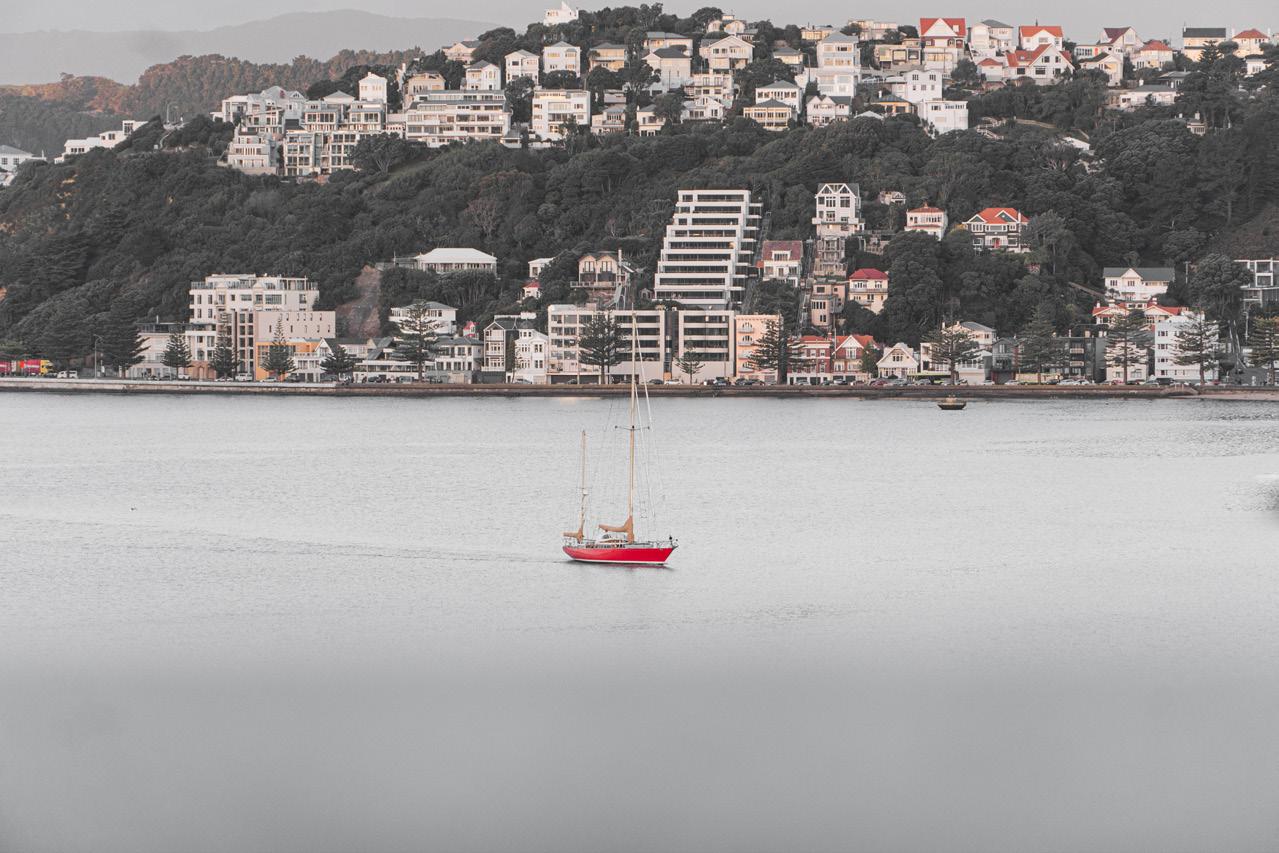
02. TARANAKI STREET
This photo was captured in the middle of Taranaki Street. For this photo, Titan wanted to replicate the colour grading and exposures unique to film. “The building drew my attention,” he says. “The architectural style, with the artwork, is so different compared to the surrounding area.” Opportunity for comparison and contrast seem to be big factors in deciding Titan’s shooting locations. Luckily, there are lots of those around the city.

19 Te Taiao ✦ 04 ✦ FEATURES ✦ AHUATANGA 19 Te Taiao ✦
MATAIRANGI/MOUNT VICTORIA
LYALL BAY
TOM LEE (HE/HIM) (PENTAX ME)—@KEKENO_PHOTOS



TE MANA O NGĀ MAUNGA, TE MANA O NGĀ K ĀHUI
Ko Tupua kawa, ko Tawhito kawa, ko Te Matoe o te rangi, tēnei hoki rā te taketake rongo, he taketake maunga, he taketake tangata, tēnei ka hora.
My maunga is my oldest tūpuna.
My maunga stands tall and protects my whanaunga, and in turn, we have a responsibility to protect him. My maunga loves and fights for what is right. My maunga lives on in me, and I will live on in him. The mauri and mana of my maunga are inseparable from me.
For many, Taranaki Maunga is a pretty picture of clean, green, beautiful, touristy Aotearoa. He’s on corporate calendars and postcards—peep overdone Pouākai Tarns reflection shots. Add what is (still) called the Egmont National Park, and you’ve got an attractive ring of bush and alpine glory people who love the outdoors will travel many kilometres to see.
For ngā uri o Taranaki Maunga—ngā uri o Taranaki Iwi, Te Ātiawa, Ngaa Rauru Kiitahi, Ngāruahine, Ngāti Maru, Ngāti Mutunga, Ngāti Ruanui, and Ngāti Tama—that pretty picture is a lifeline.
He’s the reason we are who we are. The trees, plants, birds, and freshwater that have sustained our people for generations are the children of Taranaki and Pouākai (the maunga next door). Without our awa, there are no fish to eat. Without our manu, there are no korowai to protect us. Taranaki Maunga is also the gateway to our atua, the place where we can access the metaphysical realm that keeps us connected to who we are.
Soon, our maunga will be a legal person.
Over the last ten years, Treaty of Waitangi settlements between the Crown and iwi representatives have seen the creation of Pākehā legal mechanisms to give legal personhood rights to some maunga, awa, and whenua. Te Urewera, the heartland of Ngāi Tūhoe, was granted legal personhood in 2014, and then Whanganui River, followed in the 2017 Te Awa Tupua arrangement.
Next up, Taranaki Maunga.
Legal personhood gives our tūpuna real legal power in the Pākehā legal arena. Whilst they can’t do all the things most humans can do in law, like get married, legal persons can own assets, participate in legal proceedings, make submissions on resource consents, and much more.
To give you the Taranaki Maunga context, a Collective Deed of Redress (called Te Ruruku Pūtakerongo) between the Crown and all eight iwi o Taranaki will make provision for Taranaki Maunga and all maunga located in the current Egmont National Park to be one legal person. They will be known as Te Kāhui Tupua.
Te Ruruku Pūtakerongo is founded in a framework called He Kawa Tupua, which is based on whakapapa and the natural hierarchy of the maunga as tūpuna. “Effectively, what we say is ‘the maunga first and foremost’,” said negotiator Jamie Tuuta (Ngāti Mutunga, Ngāti Tama, Ngāti Maru, Te Ātiawa, Taranaki Tūturu) at an information hui on 17 July. “The broader arrangements are about the health and well-being of the maunga.”
There are two aspects to He Kawa Tupua. First, Te Mana o Ngā Maunga recognises all Taranaki maunga have legal person status, embeds a set of intrinsic values around the arrangement, establishes Te Tōpuni Kōkōrangi (the human face and voice of Te Kāhui Tupua), and includes other changes that affect the well-being of the maunga. Secondly, Te Mana o Te Kāhui is grounded in the connections human uri of the maunga have with them. This part of the deed acknowledges a collective statement of iwi relationship to the maunga, establishes a collective entity for ngā iwi o Taranaki, and outlines how the national park (to be renamed Te Papa-Kura-o-Taranaki) will be managed.
The length of Te Ruruku Pūtakerongo matches up with the importance of the arrangement for our people, future ngā iwi o Taranaki relationships, and the battles that were fought by our tūpuna to get where we are today.
23 Te Taiao ✦ 04 ✦ FEATURES ✦ AHUATANGA
Words by Tessa Keenan (she/her; Te Ātiawa)
LEGAL PERSONHOOD IS MORE THAN JUST LAND BACK: IT IS A LEGAL RECOGNITION OF THE HIGH STATUS OF OUR TŪPUNA .
Staying in the Taranaki Maunga context, flash back (at your own risk) to when the Crown stole Taranaki Maunga and other maunga in 1865—as well as almost all whenua in the Taranaki region. Then, flash forward to 1978, when the Taranaki Māori Trust Board were given back Taranaki Maunga, on the premise that the Crown immediately steal him back “as a free gift and as a symbol of love to all the people of New Zealand”. The Waitangi Tribunal has found there was probably no “evidence that the hapū agreed” to the Crown stealing ‘ownership’ back. Egmont National Park is still the only remaining national park on whenua raupatu (stolen land).
Usually, a Treaty of Waitangi (note: not Te Tiriti o Waitangi) settlement with the Crown is the opportunity for iwi (note: not hapū) to get back some (note: some) of their whenua that was stolen. But with the maunga being tūpuna, Tuuta explained, “it didn’t feel right for iwi to own them”.
Legal personhood is more than just land back: it is a legal recognition of the high status of our tūpuna.
Kaiwhakahaere-ā-tau Tuatoru of Ngā Rangahautira, Christie Wallace (Te Atihaunui-ā-Pāpārangi, Ngāti Apa), grew up in Whanganui and is an uri of Te Awa Tupua o Whanganui and Rātana. She says that legal personhood “meant everything to Te Atihaunui-ā-Pāpārangi iwi. It was the conclusion of the iwi’s grievances with the Crown that span over 100 years; during which the iwi had asserted their claim of ownership over Te Awa Tupua through protest, petitions, litigation, and other formal objections.”
As for the flaws of Te Awa Tupua arrangement, Christie says, “Legal personhood over Te Awa Tupua fails to vest ownership over the river in Te Atihaunuiā-Pāpārangi despite the fact that the iwi consistently sought and asserted ownership [...]. As a result, the iwi misses out on the material gains founded in property ownership and the mechanisms available to iwi to enforce their rights in the river may be considered illusory.” In this propertycentric country, monetary gains and power may be the only tangible way that iwi can exert their rights over tūpuna.
Though iwi won't own their tūpuna in the sense of Pākehā ownership, legal personhood arrangements can restore the ability of iwi and hapū to exercise kaitiakitanga (see Te Waikamihi’s article on page 14!) as best they can. Ngā Rangahautira Tumuaki Kaea Hudson (Ngāti Hine, Ngāti Awa, Ngāi Tūhoe), whose whenua is buried at Te Urewera, reflected on the legal personhood of Te Urewera. “In some ways, it 'gave back' Te Urewera for the modern formation of Tūhoe to awhi, tiaki and tautoko. Te Urewera is pretty central to the Tūhoe way of life, our hītori and kōrero. Legal recognition of its importance doesn't define it but it is a step in the right direction.”
Is it worth the struggle to recognise, as Kaea put it to me, “what Māori have always known”? The negotiators of Te Kāhui Tupua arrangement faced a lot of pushback from the Crown, and at times, walked away from negotiations completely. The Crown said, outright, that Te Urewera arrangement was not to be replicated — that is, a national park was to remain
24 ✦ Te Taiao 04 ✦ FEATURES ✦ AHUATANGA
"
"
on the maunga. They also refused to negotiate the inclusion of water management provisions, likely due to the upcoming Three Waters situation.
Representatives of ngā iwi o Taranaki still managed to push the boundaries for our people. He Kawa Tupua and the values contained in it must be upheld by DOC at every stage of their administration of Te Papa-Kura-o-Taranaki. When it comes to interpreting He Kawa Tupua, the reo Māori version will be the one followed. As for the human face and voice, says Tuuta, “There’s sufficient optionality and flexibility around what we can do.” Te Tōpuni Kōkōrangi has wide decision-making powers and can enter into relationships with agencies that will benefit the maunga themselves.
Conservation is at the heart of the Crown’s stance on legal personhood of maunga, awa, and whenua. From a Pākehā perspective, conservation can look like stopping people from being in these places altogether. But “conservation should not be about shutting people out”, says Tuuta. Nothing in legal personhood arrangements bars iwi and hapū from doing what they need to to be kaitiaki and maintain their relationship with their tūpuna.
Despite being fans of conservation, the current national park funding framework means the money the Crown makes from people with concessions to operate businesses on the maunga is not directly invested back into the wellbeing of the Taranaki maunga. When the new arrangement comes into play, Te Kāhui Tupua will have to “fix the things the Crown hasn’t actually done” themselves, said Tuuta.
The classic questions I have as a critical Māori law student float around in my mind. If these arrangements are made within the bounds of Pākehā law, are they really recognising the tino rangatiratanga of our tūpuna and ways of life guaranteed to us in Article 2 of Te Tiriti?
The arguments of Ani Mikaere (Ngāti Raukawa, Ngāti Porou), Kaihautū Whakatupu Mātauranga at Te Wānanga o Raukawa, in ‘Tikanga as the First Law of Aotearoa’, help me find an answer.
“I do not think we should settle for mere improvements in the Pākehā system as the ultimate goal… We have to remember our tikanga is the product of tino rangatiratanga, whereas creations of Pākehā law… are products of Crown sovereignty”. We cannot view Te Kāhui Tupua arrangement entirely as a product of tikanga, as it was created wholly by the colonial laws of Aotearoa, such as deeds of settlement and legislation. This is exemplified by the fact that four members of Te Tōpuni Kōkōrangi—that is, half—are to be appointed by the Crown. Um, red flag? Why do we need the Crown to decide half the face of our maunga?
From the perspective of negotiator Liana Poutu (Te Ātiawa, Taranaki), “The role of those people [...] is not to advocate a Crown position, or an iwi position. Their role is to act on behalf of our maunga.” The four members appointed by the Crown do not have to work, or even represent, the Crown, Poutu pointed out, and she hopes our people will be prioritised.
Besides, Kahurangi Dame Tariana Turia (Ngāti Apa, Ngaa Rauru, Ngāti Tūwharetoa, Whanganui Iwi) was the first Crownappointed member of the face and voice for Te Awa Tupua.
Colonial law is not going away just yet, and to ignore that would be to deny the hard work of our tūpuna to get us where we are today. “We haven’t had to fight for our reo” in the way our tūpuna had to, Tuuta explained. This means we can focus on centering our reo and tikanga in our legal personhood arrangements, and do it for those who couldn’t be here to see it.
Christie says that, on a bigger level, legal personhood goes towards the recognition of tikanga in the dominant legal system. “It provides a rationale to conceptualise Māori values, such as the personification of natural resources and the obligations people have to protect our natural environment. [This is] a step away from traditional Western notions of property which views rivers and other natural resources as something to be owned, commodified, and exploited.”
As for the future, for ngā iwi o Taranaki, it’s looking collaborative (if Te Ruruku Pūtakerongo gets ratified by voting members, that is). Negotiating the arrangement is the first time all eight iwi have worked together in this way. The arrangement, Poutu says, “gives us a legal entity, we’re able to do things together [within]”. After legislation enables the arrangement to legally exist, it will still take time to create the management plan for Te Papa-Kurao-Taranaki and fully implement He Kawa Tupua. As a ‘cultural’ settlement, ngā iwi o Taranaki are not going to make personal gains. All money invested and given in this settlement is for the benefit of the maunga.
“Where the co-governance structures created under legal personhood inhibit iwi authority to manage the natural resources affairs [...] then this might call for different approaches to that aspect of legal personhood,” says Christie on the future of legal personhood arrangements. Though settlements are ‘full and final’, there should be scope within them to get creative and realise their purpose if it's not being met.
The future, for me, is where Aotearoa acknowledges and acts in accordance with the way we, and our tūpuna, view the maunga. I want people to give him the respect he deserves.
Though the obvious raru with the Crown remains for me, I am excited for my maunga. I am excited to obnoxiously correct the old, white men of the Taranaki region when they say ‘Mount Egmont’. He will be Taranaki Maunga only!
My nana spent the last part of her life working as a negotiator for the Te Ātiawa ki Taranaki settlement, and I am immensely proud of the battles she, my tūpuna, whānau, and whanaunga have won to get us to this point. I have hope my mokopuna will enable Taranaki Maunga to have a say in the running of Aotearoa as a whole.
If you are registered with one or more of the eight iwi o Taranaki, you can vote on Te Ruruku Pūtakerongo. For more information, visit taranakimaunga.nz
25 Te Taiao ✦ 04 ✦ FEATURES ✦ AHUATANGA



26 ✦ Te Taiao
FORESTED MICRO
Ibreathe in and inhale the smell of dampness and cold and rot. It’s a rich smell: full of growth, moistness, and winter after rainfall. The water seeps through the trees, through the fallen leaves coating the ground, the mulch forming underneath; slinks between the soil and the granules of stone and past all of the tiny critters chewing, munching, decomposing. It runs down into the deep reservoirs and buried rivers that run beneath suburbs. I step over the leaves and keep walking.
The lichens growing over white fence-posts thrive in dampness, as does the moss interwoven through the path. The fungi, yet to surface as mushrooms, thrive too— it will be their season soon. Me? I try not to slip on the wet concrete on my way down. I try to savour my submersion into the microforests of the city, yet, all too soon, I’m surfacing from beneath the tree’s canopy into city streets crammed with cars and buses streaming past. The smell from the microforest of the path starts to fade, and burning fuel fills my lungs instead.
I live in the hilly suburbs of Wellington. To get to the city, I have to criss-cross down the paths and shortcut between houses, down stone stairs next to a little river of gutter water. Crossing streets, bridges above me, through tunnels, over parks with wide, curated paths and lawns. Emerging from tree covered paths to the city bustle, dipping in and out between microforest, suburb, and CBD; between life-worlds on my journey down, down, down.
Wellington is unlike any city I know. I often think, ‘Who in their right mind decided to build a city here?’ Who plonked these houses between hills and crammed a capital into valleys, where the wind tunnels, and the rain chases you downhill, searching for rivers covered by concrete, searching for spaces between buildings?
No one chose this, exactly. When the New Zealand Company—famously capitalising colonisers—arrived to what they’d decided would be Wellington, they had mapped out a gridlock city, sectioned off parcels of land, and sold it off without ever buying it themselves. They had never stepped foot here.
It was 1839, and on arrival, they were met by steep hills, deep valleys, and impenetrable bush. But they’d already sold the land—which was not theirs to begin with—to settlers, so they made do with this hilly city. They carved roads into valleys, tunnelled through hillsides, and built steps and winding paths. The hilly city was pedestrianised out of necessity—people only had their feet. Patches of native bush persisted between wooden homes—the mould and mildew found new, now domestic, places of inhabitation.
Colonisers also covered up the awa—the rivers and streams—sending them underneath the city, hiding the eels of the water from the sunlight.
It was the trend in the new, worldly colonial cities of the time to build a green belt. Thick strips of bush were left standing, wrapping around the guts of the city, holding it in, keeping it from sprawling outwards. The green belts were for the wealthy to peruse at their leisure, to breathe something of ‘wilderness’, without ever leaving their backyard. Wellington got a town belt, simply by luck of the trend, running a seal around the inner city and the outer suburbs.
Wellington’s inner town belt is grounded in greenery— tree roots retain our slippery streets through wet winters. The original town belt was more than 1000 acres and bent in a horseshoe shape around the city. It was an undivided green trailing, from the top of Matairangi to the Mount Albert ridge south of Newtown and Berhampore, up through Brooklyn, curving around Kelburn to the Botanic Gardens, and ending at Te Ahumairangi.
The town belt, like most of Te Whanganui-a-Tara, is stolen land. The Waitangi Tribunal report for the Port Nicholson Settlement Block—the area of Wellington’s colonisation—identified that the town belt area was taken illegally from Māori in 1841, without consent, consultation, or payment. The land was vested into the reserves for the city, and later passed into the hands of the Wellington City Council, becoming unavailable for treaty settlement to Taranaki Whānui ki te Upoko o te Ika.
27 Te Taiao ✦ 04 ✦ FEATURES ✦ AHUATANGA
Words by Maia Ingoe (she/her)
Since its establishment in 1840, the town belt has been chopped up and divided with chunks repurposed for building. Victoria University’s Kelburn Campus is one of them. One-third of the land was used for purposes not originally intended, dividing the town belt into blocks of green thriving in the small spaces between the city, never further than a short walk away: the microforests.
The green spaces that interest me exist in the spaces in between the town belt. The trees covering paths from Garden Road to Glenmore Street. The moss-covered, winding stairs down to Kelburn Parade. The microforests next to Salamanca Road, following the City to Sea walkway. Wellington City is spoiled with green; stand anywhere with a view, and it’s easy to see the buildings lodged between nature. Unhindered by our human influence, it could keep growing around and above us, enclosing us in a forest-submerged cityscape. More than one-third of the central city’s public green space is not enclosed in pristine parks and gardens, but rather in roadside reserves, non-council areas, and slopes that cannot be maintained. We are never far from feral, untamed space. ✦
✦ ✦
If you couldn’t already tell, these forest paths were playing on my mind. I knew I needed an expert, someone with a lifetime of knowledge, and I was pointed to the path of Ellen Blake.
Ellen works with Living Streets Aotearoa, and has been walking the paths of Wellington for much longer than I. Living Streets campaigns for walkability: that is, a city set up so people can easily walk to work, to amenities, to the supermarket, the doctors, to friends. Walking, she says, is for everyone: it’s free, and many people don’t have a choice but to walk. And Wellington’s paths and shortcuts are many. It comes back to the ill-planned colonisation, Ellen explains. Most people didn’t have any option but to walk in the 19th century, so building paths that carved a way through Wellington’s hillsides were a necessity.
Ellen met me on Kelburn Campus on a fine but cold day—one of those Wellington winter days where being outside is stomachable. We walked down Mount Street, past the cemetery on the left and the thin line of bush bordering the bank on Salamanca Road on the right. Turning down Salamanca Road, walking alongside the white fence posts bordering the footpath, to the stairs disappearing down into the microforest. A little yellow sign: City to Sea walkway. We turned and walked down it.
This part of the City to Sea walkway dips away from Salamanca Road and re-emerges on The Terrace. The leaf-covered steps and still-soggy ground soon ended, and the path was noticeable only by where it had been worn down by footsteps. We were surrounded by native trees; we had dipped into the bush, away from the bustle of the city and the road, into another world.
Down the bankside we went, inhaling the damp air and the smell of decomposition amongst the greenery. The sound of running water became louder, and we came to where the Kumutoto stream remerges briefly, for a breath of fresh air. This awa used to feed Kumutoto Pā, but since the 1870s, it has run through pipes from Karori, past Kelburn, and below the CBD to be released at the Whairepo Lagoon at the waterfront. Here, it tumbles out of the pipe, running across a drooping ledge of concrete to a small pool. The bank looks as if it has given way to the water, roots hang from the dirt, heavy and languished. Two sides of a fence line are separated by the dropped bank and the water. A line, a wire, a piece of rope runs between them. It’s not idyllic. The water seems as if it’s grasping for space in the air and sunshine. It feels trapped between these pipes, roads, and buildings.
Ellen and I continue our walk, emerging from the untamed forest path to something more curated: a concrete path and grass lawn. This is a park too—you can see it from the Salient office. We walk to the edge and look over the railing to see the motorway running underneath it, cars speeding through the Terrace Tunnel beneath us. Speakers linked up to the Kumutoto send the sound of running water into the tunnel.
This path, like many shortcuts in and out of the microforests growing between Wellington’s unmarked spaces, isn’t ‘walkable’. It’s overgrown and wild, the path is unmarked and unsealed. For a second, you dip below the city surface of Wellington. No one stays here for longer.
✦ ✦ ✦
The city’s green belt, and the microforests in between, are an opportunity for restoration and growth. They show us glimpses of natural ecosystems, places that live and grow alongside the environment we live with. Trails Wellington want to take advantage of this.
Trails Wellington, leveraging off investment from the likes of Xero’s founder, has become a joining force for community mountain biking, and more recently, commuter cycling groups. Matt Farrar, a trustee of Trails Wellington, ran me through their vision document: a bold outline for how the cities inner and outer green belt can be leveraged for safer cycling paths that also support native regeneration. Their plan aims to connect with Paneke Pōneke (a plan for a city-wide cycling network, from Island Bay to Johnsonville) and grow the project from its current status. Traditional benefits of creating more mountain biking trails had always been economic, creating a new market for tourism. But with the “transformational movement” looking at commuter cycling, the potential benefits for physical and mental wellbeing, supporting climate action, and native regeneration, entered the picture.
“Mountain biking can go from being a recreational sport, [and] start being a legitimate way to get in and out of the city, to not use a car, over and above Paneke Pōneke.”
28 ✦ Te Taiao 04 ✦ FEATURES ✦ AHUATANGA
Wellington is already known as the “city of trails”, thanks to the uniqueness of its inner and outer green belt. Matt compares Wellington to Copenhagen, the city most renowned for its cyclability. Sixty-two percent of people commute by bike in Copenhagen, bracing average wind speeds of 24.5kmph and 9-degree weather. Wellington is often said to be too cold or too windy for cycling, but our average wind and temperature is similar to Copenhagen at 23.5kmph and 13 degrees. But Wellington one-ups them in one way: Copenhagen has 42m2 of greenspace per person, whereas Wellington has 207m2 of greenspace. That’s space that can be utilised for mutual human and environmental benefit, Matt says.

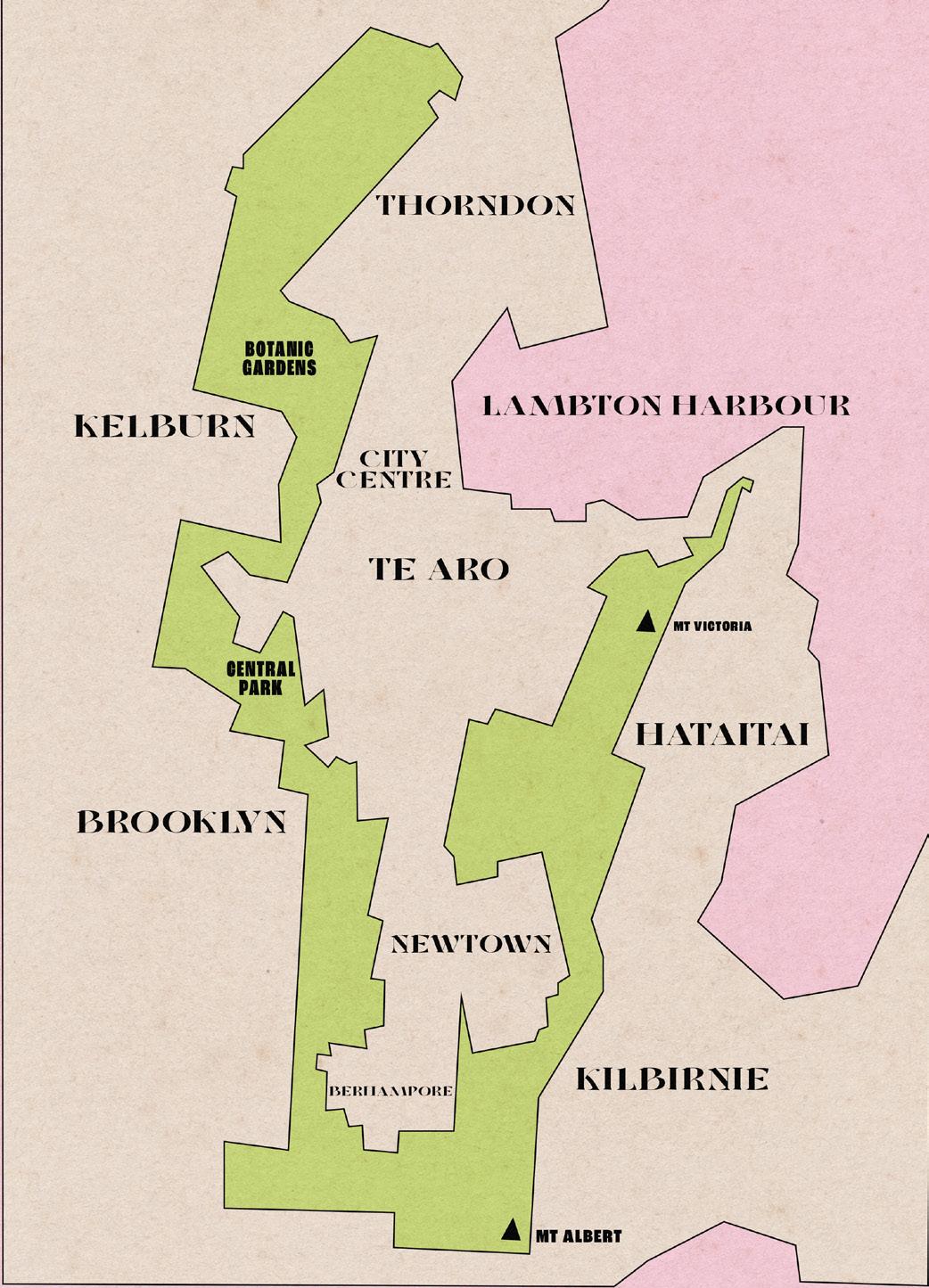
Working with world-class trail designers, Trails Wellington are looking at areas where trails can be built three metres wide, with “less than five degree steepness, all throughout the green belt, to enable commuting from the Eastern, Southern, Western and Northern suburbs.” This would make it easier for everyone to cycle in and out of greenspace on their commute—different to the roadside lanes promised in Paneke Pōneke.
Where Trails Wellington have built mountain biking trails through Waimapihi, Mākara Peak, and Matairangi, they’ve created a volunteer-force for native regeneration, planting trees for every metre of trail. At Waimapihi, 30,000 trees have been planted in the last ten years, and at Mākara, over 50,000. This is a “regeneration success story”, says Farrar, of the native planting through Mākara’s exotic forest and farmland.
✦ ✦ ✦
You may never think about the paths beneath your feet. While you’re struggling for breath climbing Mount Street to uni, you probably don’t think about the paths criss-crossing through the graveyard to Darwin Street. You probably won’t think of the fallen leaves, yet to turn to mulch, on the damp sidewalk. You won’t think about the lichen growing across the cold stone, climbing up the white-painted fences, separating the footpath from (what’s rather blandly known as) ‘greenspace’. All of these are parts of our city.
As we forge new, zero-carbon ways of urbanness, things like walking and cycling and simply noticing the surrounding nature has become more important. Wellington, in my mind, is unique, because it hasn’t banished the wild and native plants from its cityscape. They persist in between the industrial, covering streets and paths, in greenbelts and throughout microforests. The point of these things is how we can make our way through greenspace, revitalising how we understand a city, making a new path that is not so limited.
This, the green belts and microforests and footpaths, is the environment of Wellington, of Te Whanganui-a-Tara, of Pōneke. This is the grime on our boots and the rain on our fingertips. This is the kawakawa leaves and the agapanthus. It is all of it; encased in our criss-cross walk to the city. This is our opportunity.
29 Te Taiao ✦ 1840
2023
04 ✦ FEATURES ✦ AHUATANGA
ODCASTS
A Future in Fifteen Minutes
Words by Xandi Gobbi of GovernMentality Podcast (he/him)

Sorry deniers, unfortunately climate change is very real and here to stay. The flooding in Auckland was a wake up call. Climate change is forcing us to reimagine our lives in a transition to a low-carbon future. In Wellington, we’re trying to improve public transport, adding in more cycle lanes, and banning cars from the Golden Mile.
But is it enough? Instead of just rethinking how we get around, should we go further? Should we redesign our cities?
Enter 15 minute cities.
Promising a radical rethink of the way our cities are laid out, the idea is simple. Imagine a world where everything you need is just a stone's throw away. Picture yourself strolling along tree-lined streets, with your workplace, grocery store, park, and favourite café all within a 15-minute walk or bike ride from your front door. This is the essence of a 15-minute city.
Such cities could be the key to a greener future. By prioritising walking, cycling, and public transportation, 15-minute cities actively combat air pollution, reduce emissions, and create cleaner, more sustainable communities. Embracing 15-minute cities means taking a significant step towards a healthier planet.
This is all about convenience—ensuring that your daily needs are met within a short distance from your home. No more hours wasted in gridlocked cars or crowded buses. Need to grab groceries or run errands? No problem! Everything is just a quick walk away.
Perhaps the most remarkable aspect of 15-minute cities is their ability to foster a strong sense of community. By designing urban spaces that prioritise human interaction and social connection, these cities create opportunities for neighbours to engage with one another. Vibrant neighbourhood centres, green spaces, and public amenities become the beating heart of these communities, fostering a profound sense of belonging.
It is no wonder then that this idea is getting traction in cities around the world, from Melbourne to Paris. Even though turning Wellington into a 15-minute city may not be immediately feasible, it provides us with a framework for thinking about how we allocate resources in our community. One such example would be creating a public high school in Karori instead of kids having to commute into the city.
For more on how the climate is affecting this upcoming election, check out GovernMentality wherever you get your podcasts!
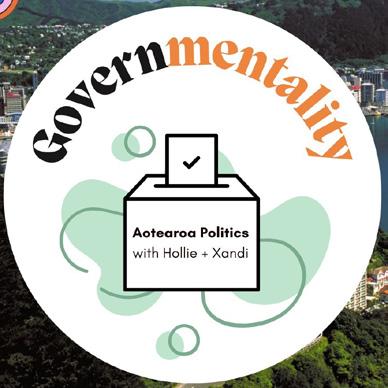
Listen to 'GovernMentality' here!

30 ✦ Te Taiao 05 ✦ PODCASTS ✦ KŌNAE IPURANGI
30 ✦ Te Taiao
TUNA KUWHARUWHARU
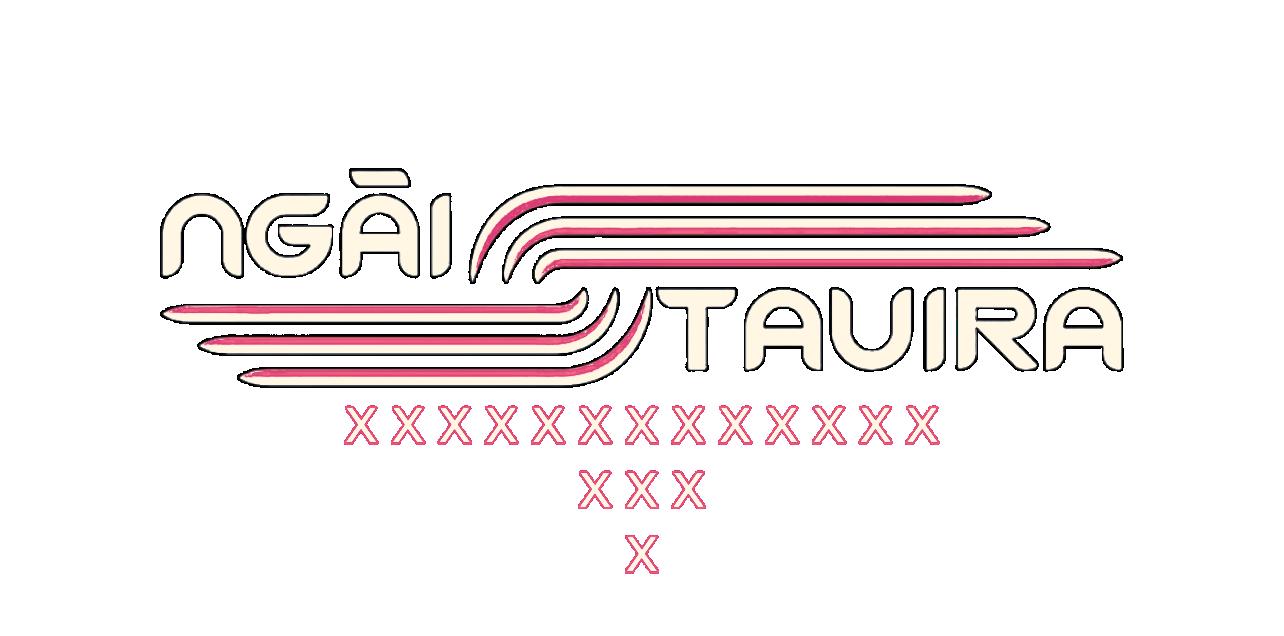
Eels: te kupu Māori mō te tuna. A type of animal that is considered culturally significant in many different aspects of Māori culture. Eels were a staple food source for Māori, and still they are an important part of many feasts and celebrations. Māori mythology and stories from different iwi say that eels were seen as ngā kaitiaki o ō tātou awa, roto, me ngā moana. Nowadays, eels in Aotearoa are facing several threats, including habitat loss, pollution, overfishing, and the effects of climate change. Some species of eels are also threatened by the introduction of non-native species. As a result, eel populations have declined significantly over the past few decades. That should sound alarm bells for actions to be taken before these awesome koha nō ngā Atua completely disappear in the near future.

31 Te Taiao ✦ 06 ✦ COLUMNS ✦ TIWAE
Words and artwork by Te Huihui o Matariki Chí Huy Tran (he/him; Taranaki, Te iwi o Maruwharanui)
31 Te Taiao ✦
Dear Aunty Vic
We want our previous flatmate and friend to come hang out at the flat, but one of our flatmates banned them. They had a fight last year which resulted in them being kicked out of the flat group. What do we do?
The cross-over between flatting and friendship can be one of the more dramatic life experiences. It's a constantly shifting dynamic that can rightfully test your tolerance and limits.
I can empathise with your situation. It’s difficult having friends your other homies aren’t a fan of. Having friends over to hang freely is one of the glories of leaving home! Kick-ons, movie nights, sleepovers— it’s a special era in your life where your best friends are a stone's throw away in their own dingy flat.
Unfortunately, your desired visitor has fucked up in a severe enough way to get them kicked out and forever banned from visiting. The question is: is this boundary reasonable and fair to you, your other cohabitors, and the desired visitor?
I would firstly advise having a one-on-one conversation with the flatmate who implemented the ban, and then your desired visitor. Revisit the argument and really try to understand each of their perspectives. This happened last year, so the magnitude of this event may have fizzled out in your mind. You may be reminded that this boundary is in fact reasonable. Or, you may find that your flatmate has processed a lot of the incident and moved on. You may find that your desired visitor is willing to apologise to your flatmate and attempt to build a bridge. The reality is, you will never know until you talk to them.
.ASecondly, I would talk to the rest of the flat. How does this situation make them feel? How does it make you feel? Work out your experiences. Do they think the flatmate is being reasonable or dramatic?


Once you have a clear understanding of where everyone stands, including yourself, look at the practical options of resolving the issue. You may find that the majority of the flat would like the desired visitor to come over, or the total opposite— they want you to keep them outta there. Could there be a halfway ground? Regardless, to keep the flat a safe space, you need to respect everyone's perspective and try to best accommodate them.
I want to iterate again that if this fight caused someone to be removed from the flatting group and be banned from visiting, I would presume it was a pretty severe fuck-up. Healing takes time, and you may find that, even a year on, some people are not ready. You must remember that a flat is someone's home. It is as equally their home as it is yours, and it is vital that it remains a safe and inviting space. Sharing a space requires compromise. If that means only catching up with your friend at a café instead of a sleepover, that may be required.
The same can be said in reverse, and I may be wrong in interpreting the severity of the incident. Your flatmate may be dramatic, and the majority of your flatmates may really want this desired visitor to come hang! If so, it is your flatmate who may need to compromise. You cannot control how they respond to this, but hopefully they can respect that same idea. It is as much your home as it is theirs.
32 ✦ Te Taiao
06 ✦ COLUMNS ✦ TIWAE
Send your anonymous questions to Aunty Vic via the Salient Linktree.
Q.
Belonging Despite Ableism
Words by Teddi (they/he/she)
Iam unsure of my place in the world, both in a physical and mental way. When I first started struggling to fit into an often ableist world, I realised that no one talked about how disabled people can’t exist in a way that makes sense to others.
I couldn’t work for two years. Even though I was studying part time, I wasn’t physically able to do anything more. Society puts a lot of pressure on people to be productive. I remember being in primary school, and everyone going around saying what jobs they wanted. Realising that common things, which everyone else experiences, like careers, might not be the same for me, was daunting. I felt that I had no purpose, and with limited income, I couldn’t really do anything like move out, get my own place, or plan for a future career. Dreams I’d been told all my life would fall right into my hands were suddenly pushed out of reach.
It felt like when Tinker Bell was no longer able to fly in Peter Pan. I didn’t believe in myself or my own future anymore.
I found out this is actually a very common thing for people that suddenly become disabled, or more disabled. In my experience, social workers (not therapists) are the best people to talk to, as they see people from all walks of life. They helped show me that there is more than one way to succeed in life, but also that ‘success’ as society defines it is not real. Find out what your definition of success is, and hunt out little ways to cherish the moments when they come rather than moving onto the next goal.
Having this column is one of my greatest successes. I was terrified when I realised I really was disabled, and at one point, I had someone say to me that my life was their worst nightmare.
But I love my life right now. I feel lucky that I get to have the conversations about how to make life easier for others with disabilities and that I am well enough to advocate for myself and others. If I have one person relate to this column, or help someone understand how to better support someone with a disability, then that is my greatest success. I want conversations on how to accommodate others to be as normal as asking what milk you want in your coffee. Lactose intolerance isn’t going to go away regardless of whether dairy milk is the only thing available—so it's better we find out how to make sure everyone can drink a coffee they like.
That being said, I can only offer my own perspective on being disabled. So I would like to open 'TeaSpoonie' up and allow other people to help work on this project, and ask how to make VUW and daily life more inclusive for people with different disabilities.
Please email TeaSpoonie.Writing@gmail.com if you would like to be involved and help normalise talking about disability.

33 Te Taiao ✦
✦ ✦ ✦
06 ✦ COLUMNS ✦ TIWAE
gran’s garden
Words by Maia Ingoe (she/her)
From time to time, and more often now my mind seeks that meditative stillness of a forgotten world solitary, yet surrounded by the hum of breath exchanged I sit and watch her, world, as minutes aren’t counted as her sun warms the rocks underneath my skin rising over the cliff above peaceful, but never quiet, as trickling waters rise through tangled thoughts, strands of hair a fish jumps, a splash long tail of dragonfly whizzes past an area birds sing, chatter, light rising on life that never pauses grass against naked stomach the strength of peace, to let thoughts go, forget the road there is only my body and the breath of wind caresses all of us, plant and animal, alike
34 ✦ Te Taiao
07 ✦ CREATIVE SPACE ✦ AUHUA
Wake up? Work. Finish class? Work. Weekend? More work. Your bank account is full and you can actually afford to eat, but ironically, your health is suffering. Sorry, no advice I’m afraid. Just validating your experience in this ass economy.
Repeat after me, Taurus: I. Will. Stop. Seeking. Validation. From. Men. They won’t grant you self esteem, only trauma. Whether you’re trying to win men over with out-of-touch jokes, or hoping they think you’re cute, stop. Love yourself.
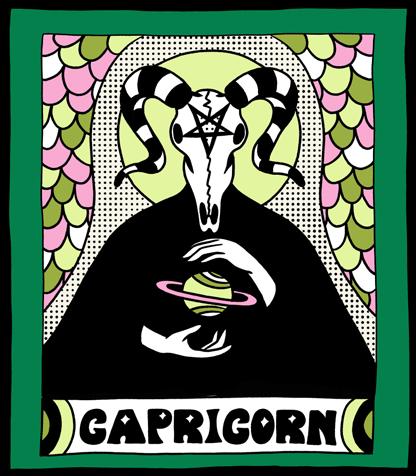

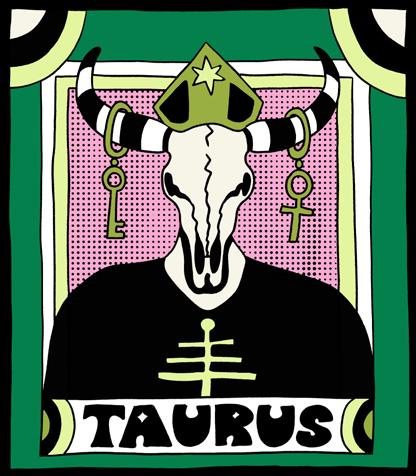
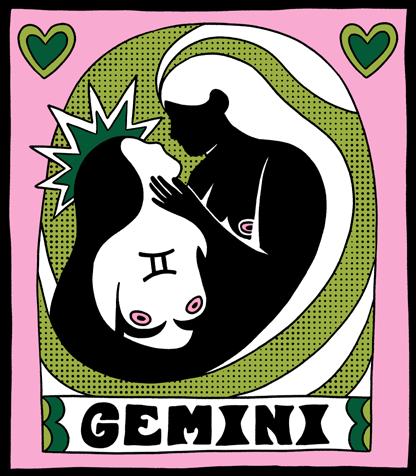
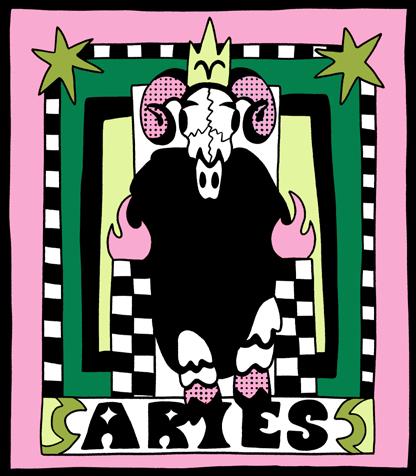
I’m just gonna tell it to you straight: your flatmates don’t give a shit if you’re working and studying. You never do the dishes. They hate it. You’re one cornflake concrete bowl away from the ‘we need to talk’ text.
Your secret will be revealed this full moon. You’re scared, but it’ll be like that time in high school when you were worried your friends would find out you play Minecraft. It turned out they all played it as well.
Oh God, did you try to change your hair yourself during this Venus Retrograde? Sir! What were you thinking? Well, it’s too late to say anything now. You’ve vowed never to look at box-dye again, and have sworn off scissors forever.
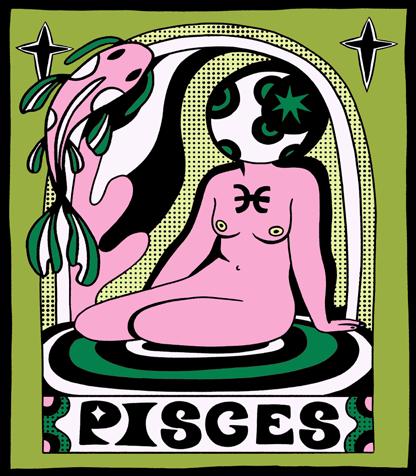

Your ex is a wanker. Stop internalising the bullshit they said to you. You’re cute. End off. No ands, ifs, or buts. Life’s too short to be crying over shitty people and even shittier relationships. Onwards and upwards.
Ooh, you might need to rethink that soul-mate best friend you made at that party the other day. I see some shady shit coming to the surface. Your flatmate has some tea, I know it.
I love the petty tension surrounding you this week. Your friend was trying to hit on your crush, but your boo’s loyalty came through. That's what we like to see. They only have eyes for you, even if the two of you ain't official yet.
Bitch, you have way too much shit due in one day. You are dying. Email for that extension! Don’t give up before trying— unless you’re a Law student… Might be on your own there. I hear they’re strict!
Something about your communication style isn't translating to your uni work. Did you make a slideshow about how to ‘gaslight, gatekeep, girlboss’ like a pro for your business assignment? Actually, I take it back. It is translating.

Yikes. I feel for you, Aquarius, I really do. You finally met the parents, annnnnndddd… they suck. Ahh… oh well. Not much you can do except avoid future dinners and refuse to laugh at their problematic jokes. My prayers are with you.

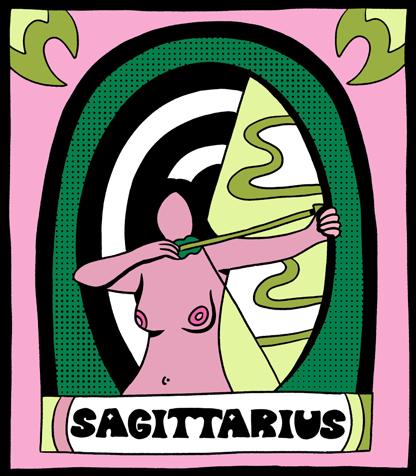
Not more conflict with your partner. Oh my. What did they say that hurt your feelings so much? Time to stand up for yourself. Don’t let anything go unsaid, ‘cause I feel the resentment building. Air that laundry out.



35 Te Taiao ✦
35 Cupid ✦ Health & Disability
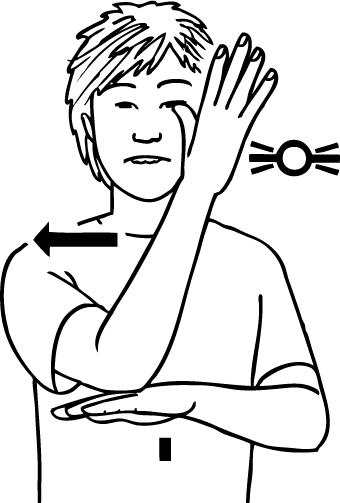

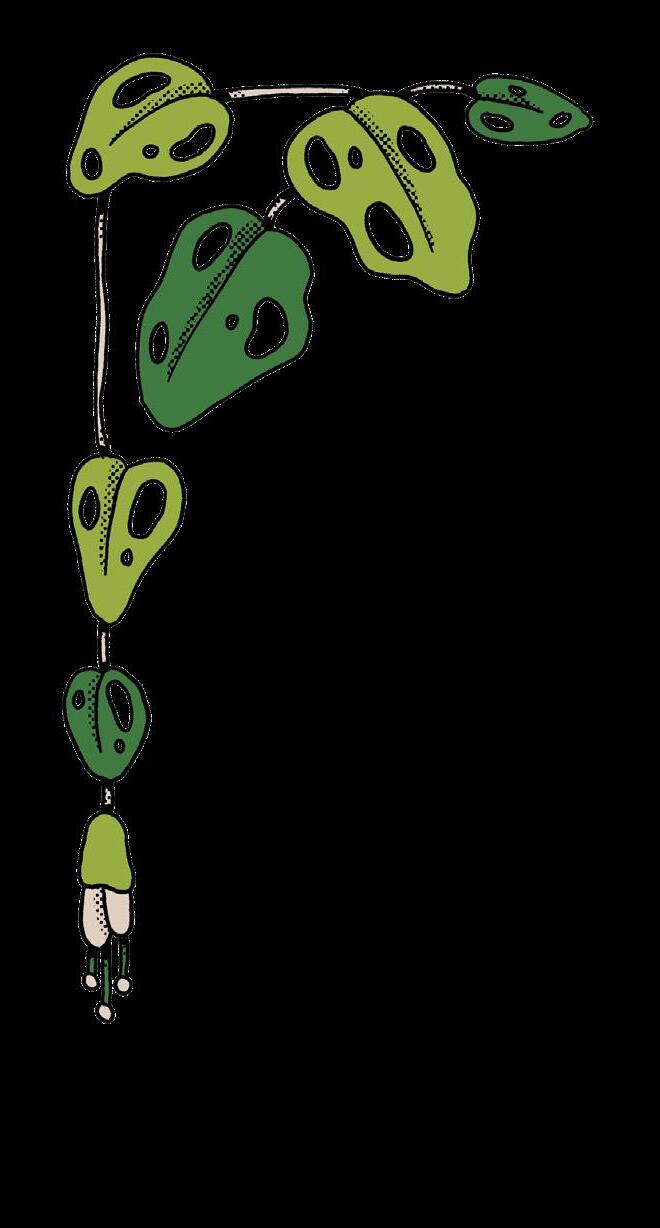

36 ✦ Te Taiao brain boozled 09 ✦ PUZZLES ✦ PANGA eb Sudoku - Billions of Free Sudoku Puzzles to Play Online https://www.websudoku.com/?level=3 Hard Puzzle 3,267,102,891 Back to puzzle Print another © Web Sudoku 2023 - www.websudoku.com 6 3 2 9 1 2 7 8 6 2 4 1 1 2 4 2 6 7 2 4 3 8 ngahere WORD OF THE WEEK: FOREST NZ Sign Language
ACROSS
1. 1965 hit musical with the songs 'My Favourite Things' and 'Do-Re-Mi' (3,5,2,5)
9. Scooby Doo's breed (or Hamlet's, in a sense) (5,4)
10. Word that can precede case, jaw, or Hutt (5)
11. Gone bad (6)
12. One of South Africa's capitals (8)
14. New Zealand player who scored the opening goal of the 2023 FIFA Women's World Cup (6,9)
16. Takes part in a sport or competition (8)
18. Give high credit to (6)
21. Steam room (5)
22. It lasts about nine months in humans, and more than 21 for elephants (9)
23. "Aotearoa's leading materials recovery and recycling provider", according to their website (5,10)
DOWN
1. Largest species of the big cats (5)
2. Premier League team based in Liverpool; Te Herenga Waka hall of residence (7)
3. In agreement (2,3,4,4)
4. 'Born a Crime' author and former 'The Daily Show' host Trevor (4)
5. Dismiss, as a judge might do to an objection (8)
6. The Alps or the Southern Alps, for example (8,5)
7. Aotearoa's retirement savings plan, for short (5)
8. Sure; specific (7)
13. Common climbing plant with pink or purple flowers (5,3)
14. Hand tool often used in movies to cut through handcuffs (even though bolt cutters are way more common and much faster) (7)
15. Microbiology or meteorology, say (7)
17. Attacks severely; large hammers (5)

19. Country where you can visit the Abu Simbel temples (5)
20. Company whose franchises include 'Total War' and 'Sonic the Hedgehog' (4)
37 Te Taiao ✦
Find our crossword answers on our website or the Salient Linktree. 09 ✦ PUZZLES ✦ PANGA
Goal Oriented

THE TEAM
CO-EDITOR
Maia Ingoe (she/her)
CO-EDITOR
Francesca Pietkiewicz (she/they)
DESIGNER
Bella Maresca (they/them) @cupids.kiss
NEWS EDITOR
NEWS EDITOR Zoë Mills (they/she)


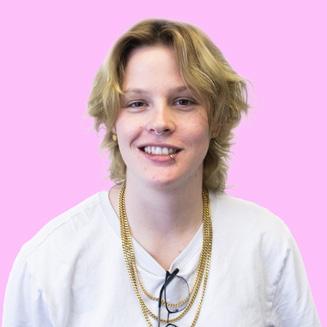



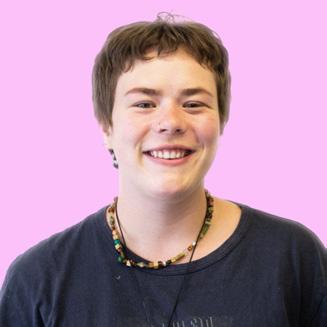



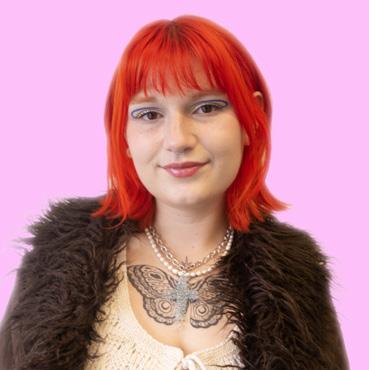
Ethan Manera (he/him)
CHIEF REPORTER
Niamh Vaughan (she/her)
PODCAST MANAGER
Alex Marinkovich-Josey (he/him)
PODCAST INTERN
Simoné Botha (she/they)
SUB-EDITOR
Tessa Keenan (she/her)
POETRY EDITOR
Maia Armistead (she/her)
EDITORIAL SUPPORT
Joanna Fan (she/her)
STAFF WRITER
Kiran Patel (he/they)
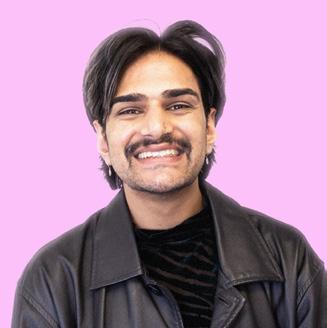
STAFF WRITER
Phoebe Robertson (she/her)
CONTRIBUTORS
Bridey Newell (they/them)
Te Waikamihi Lambert (she/her)
Te Huihui o Matariki Chí Huy Tran (he/him)

Teddi (they/he/she)
Ella Hoogerbrug (she/her)
Xandi Gobbi (he/him)
STAFF WRITER
Pippi Jean (she/her)
COVER
Photographer: Grace Kavanagh (she/her) @grace.lulu
Model:
Rīpeka Raihania (she/her) (Ngāi Tāmanuhiri, Rongomaiwahine, Ngāti Porou, Ngā Puhi, Te Aupōuri) @bexraihania

VIDEO CONTENT CREATOR Seren Ashmore (he/him)
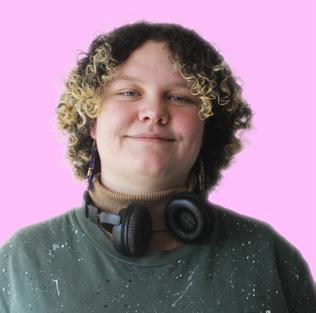
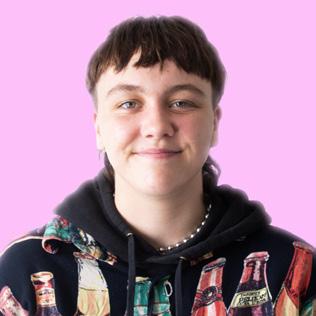
Willem Koller (he/they)
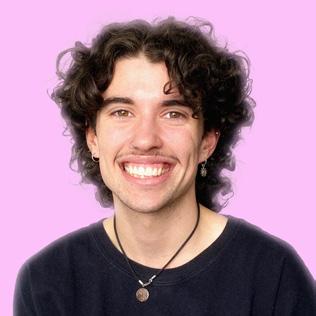
SOCIAL MEDIA MANAGER
Ethan Rogacion (he/him)
NEWS INTERN Jia Sharma (she/her)

WRITING INTERN
CENTREFOLD ARTIST
Keelin Bell (he/him) (Ngāti Maniapoto, Ngāti Porou, Ngāpuhi) @the_all_blue_seeker
39 Te Taiao ✦
✦ NGĀ MIHI ✦


































 Written by historian Peter Frankopan,
Written by historian Peter Frankopan,





 Words by Pippi Jean (she/her)
Words by Pippi Jean (she/her)




































































